The Tidal Rum
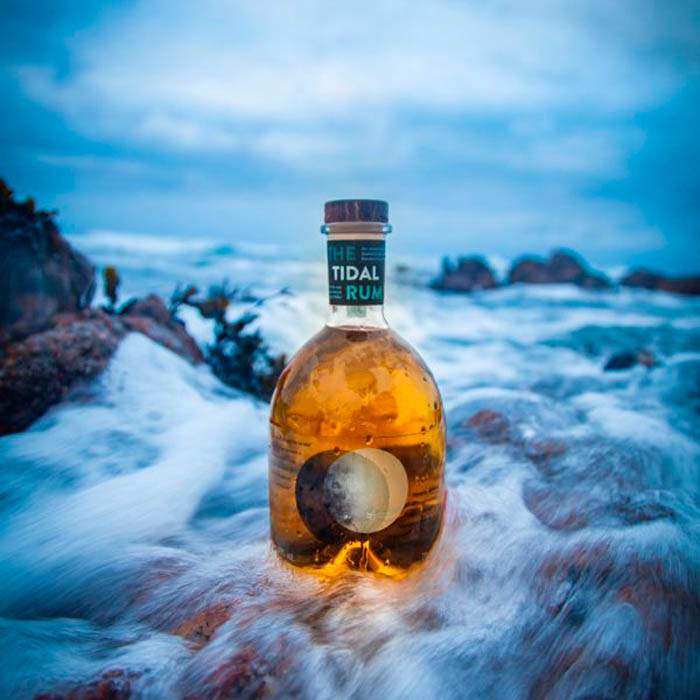 Shorts Boy Distillery on the island of Jersey infuses a blend of four Caribbean rums with pepper dulse and ages it for two to three years in oak barrels. The rums originate in Barbados, the Dominican Republic, Jamaica and Trinidad in undisclosed proportion. The barrels once held Bourbon so they impart a smokey flavor that is surprising in its subtlety. The dulse tastes of minerality and of course is salty but in common with the smoke the saline tone of the rum is slight, also something of a surprise because the people at Shorts Boy run their seaweed through a smoker. Color is pale gold so they do not appear to resort to dye. The finished rum is fairly smooth--it benefits, like good malt whisky, from a drip of water--dry instead of sweet but not astringent and without a trace of the expected iodine. By no means a flavor bomb in the manner of Smith & Cross or Pampero Anniversario in their contrasting ways but interesting, pleasant and an excellent addition to a collector’s rum cabinet.
Shorts Boy Distillery on the island of Jersey infuses a blend of four Caribbean rums with pepper dulse and ages it for two to three years in oak barrels. The rums originate in Barbados, the Dominican Republic, Jamaica and Trinidad in undisclosed proportion. The barrels once held Bourbon so they impart a smokey flavor that is surprising in its subtlety. The dulse tastes of minerality and of course is salty but in common with the smoke the saline tone of the rum is slight, also something of a surprise because the people at Shorts Boy run their seaweed through a smoker. Color is pale gold so they do not appear to resort to dye. The finished rum is fairly smooth--it benefits, like good malt whisky, from a drip of water--dry instead of sweet but not astringent and without a trace of the expected iodine. By no means a flavor bomb in the manner of Smith & Cross or Pampero Anniversario in their contrasting ways but interesting, pleasant and an excellent addition to a collector’s rum cabinet.
Pot au Feu, Providence, RI
Pot au Feu is a delightful and aggressively Old School French bistro in Providence, Rhode Island. The chef is a licensed mushroom forager, apparently the only one in the state who runs a kitchen so the place offers peerless wild mushroom soup and paté among its traditional dishes--bouillabaisse, cassoulet, a big lamb shank, of course pot au feu. They know who they are and want you to know too, not least so you can stay away. The proprietor, Bob Burke is congenial; also honest and brave so posts a stern warning at the Pot au Feu website in this white on black format:
This is a sample dinner menu -~
Prices and availability of menu items will be different when you come for dinner.
Please, do not complain about those differences when you come to dine - we will not match prices or magically have items available.
We are much more focused on the experience guests have at the restaurant than we are on our keeping our website updated. We love serving our guests at the restaurants - the whole online thing - not so much.
Warning
We are old school - if you are looking for the newest, latest, "next big trend" in food we are definitely not a place you should choose to be dining.
Yelpsters, self identifying foodies and cry babies- please, stay away - we are not a place you should dine. Pot au Feu is not foodie friendly. Swipe left!
Save us all the misery. You were warned!
The rest of humanity is warmly welcome – bienvenue à Pot au Feu!
Savories of any sort, along with tapas the original small plate but intended for a different purpose, resetting the palate for more Port following dessert but equally suitable for a supper of snacks. We review a few good books in the critical.
 Big Ben blades for straight razors are nothing special except for the throwback name and graphics on the tiny package. The fact that they come from, flourish, Egypt and free with a German hairbrush renders them curiouser and curiouser….
Big Ben blades for straight razors are nothing special except for the throwback name and graphics on the tiny package. The fact that they come from, flourish, Egypt and free with a German hairbrush renders them curiouser and curiouser….
Old Bay hot sauce. McCormick has been busy affixing its Old Bay brand to everything from T-shirts and stockpots to peanuts, popcorn and potato chips, goldfish crackers, French fries, chicken sausage, beer (in collaboration with Flying Dog, a gose) and more. Hot sauce is a logical adjunct and a good one.
Orienlal mascod Spice for Spiced Food [sic] from Taiwan is worth stocking for its colorful and comforting instructions, rendered in a creative language that outshines Joyce or O’Brien, alone: “
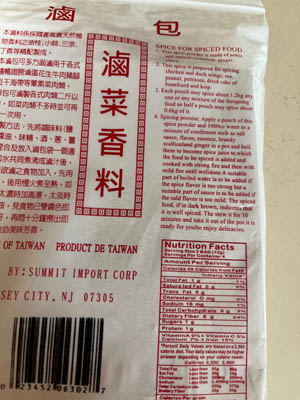 This spice powder is made of noble and natural cinnamon, ginger, and clove [but also contains fennel and the list of ingredients refers to zingiber instead of ginger, which muddies things; Plants of the World Online includes 199 varietals]
This spice powder is made of noble and natural cinnamon, ginger, and clove [but also contains fennel and the list of ingredients refers to zingiber instead of ginger, which muddies things; Plants of the World Online includes 199 varietals]- This spice is prepared for spicing chicken and duch wings, roe, peanut, pettitoes, dricd cake of beanfcurd and keip. [a pettitoe is a pigfoot but Orienlal mascod may be referring to potato; either ingredient would work so we plump for trotter which, given the company’s linguistic and apparent culinary range, is not unlikely]
- Each pouch may spice about 1.2kg any one or mixture of the foregoing food so half a pouch may spice about 0.6kg of it. [helpful calculations for the mathematically impaired or merely humanities minded]
- Spicing process: Apply a pouch of this spice powder and 1000cc water to a mixture of condiment such as salt sauce, flavor, essence, brandy scallionland ginger in pot and boil them to become spice juice te, which the food to be spiced is added and cooked with strong fire and then with mild fire until welldone. A suitable part of boiled water is to be added if the spice flavor is too strong but a suitable part of sauce is to be added if the said flavor is too mild. The spiced food, if in dark brown, indicates that it is well spiced. The stew it for 10 minutes and take it out of the pot it is ready for youlto enjoy delicacies.”
Hours of entertainment for only $2.25 without even sampling the joys attendant on welldone, noble and natural dark brown spiced dricd cake of beanfcurd with pettitoes and keip marinated in salt sauce and brandy scallionland juice te. Serve it up, as they used to say, with rice, and make it instant.
Chinese Sausages , or as they describe them  “uncooked Chinese style sausages,” manufactured by Orchard Sausages Inc., in Brooklyn, New York, make a handy base for any number of Chinese American and other Asian inflected dishes, from bracing salad to fried rice and vegetable laden stirfries; also tangy additions to scrambled eggs or unconventional gumbos, especially those featuring dried shrimp and other ingredients common to both Asian and Louisiana larders. The Orchard sausages throw a fair amount of flavorful fat, so no additional oil usually is required for rice based dishes, stir fries in general or even the salads.
“uncooked Chinese style sausages,” manufactured by Orchard Sausages Inc., in Brooklyn, New York, make a handy base for any number of Chinese American and other Asian inflected dishes, from bracing salad to fried rice and vegetable laden stirfries; also tangy additions to scrambled eggs or unconventional gumbos, especially those featuring dried shrimp and other ingredients common to both Asian and Louisiana larders. The Orchard sausages throw a fair amount of flavorful fat, so no additional oil usually is required for rice based dishes, stir fries in general or even the salads.
The sausages made with pork appear in five varieties; the original recipe, a variant made with a generous proportion of duck liver, one that is ‘90% lean, and others laced with red pepper or soy sauce. Chicken sausages are an option for those averse to pork or inclined toward something blander. We are partial to the slightly pungent sausage with liver. Orchard Sausages also offers whole cured four pound ducks vacuum sealed in four pieces; cured duck legs; cured duck gizzards; Chinese bacon; and dried pork with ginger. Exemplary products that keep almost indefinitely under refrigeration, all of them available online from, appropriately enough, www.orchardsausages.com and from Chinese markets in the northeastern United States. All the products sell at an extremely fair price and shipping is more than reasonable at a flat four dollars for orders of fifty dollars or more and eight dollars for orders costing less.
Lakeland Dairy “Creamer in a Stick” and “made from cow’s milk” does not sound promising and is not something to recommend for those treading terra firma. Usually something ‘made from something’ is loaded with something less palatable than the identified ingredient but in the case of the Stick its contents are “UHT 10% milkfat,” nothing more. The ultrahigh treatment leaches away some depth and flavor but the product is a lot more palatable in coffee than the 1% milk or, worse, Coffee Mate and its equally nauseating cousins typically carried onboard aircraft.
Coconut Macaroons found in convenience stores across northern New Jersey are as good as their counterparts from the most rarefied patisseries in the City of New York or anywhere else. At a uniform price of a buck apiece, the little ridgy disks that measure about two inches across represent extremely good value for money. The nature of the macaroons baked by various companies, including La Bayamesa in north Bergen and Daisy’s Bakery in Clifton, is uniform as well.
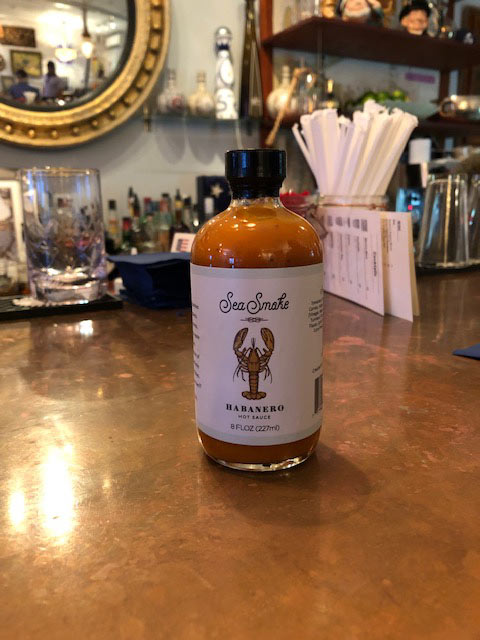 Its label reading “Sea Snake Habanero Hot Sauce” does not do its flavor justice. Sea Snake has some pop but is not crude heat bomb; constituents also include tomato, rice vinegar, onion, carrot, then the habanero, sugar, mustard, garlic, salt, a trace of curry and some black pepper. At once saucy and subtle; available from “Ten” on Bay Street in Watch Hill, Rhode Island.
Its label reading “Sea Snake Habanero Hot Sauce” does not do its flavor justice. Sea Snake has some pop but is not crude heat bomb; constituents also include tomato, rice vinegar, onion, carrot, then the habanero, sugar, mustard, garlic, salt, a trace of curry and some black pepper. At once saucy and subtle; available from “Ten” on Bay Street in Watch Hill, Rhode Island.
The Scanpan Windsor Pot. Scanpan manufactures its pots and pans in Denmark exclusively from recycled aluminum “combining,” accurately enough as its website claims, “innovative Danish design, artisanal techniques and high-tech production methods.” The products are beautiful in a serious muscular manner. Scanpan pressure casts each heavy nonstick implement except for its pressure forged, thickened base. Dishwasher safe but snappy to clean by hand, a Scanpan pot also is compatible with metal utensils. The Windsor pot is ideal for cooking finicky heirloom grits, our intended purpose in purchasing it, but is pretty much peerless for any number of preparations. Extremely good value at its high price for the serious and underconfident cook alike.
Sofrito’s Bakery in Cranston bakes outstanding examples of wonderful Rhode Island oddities, spinach pies and pizza strips . The pies resemble pasties with a softer dough and are baked precisely to create a golden pastry and avoids overcooking the spinach that retains its sweet tang; malt vinegar is the essential accompaniment. The strips are not quite pizza, a thicker, softer pastry base, no cheese; just pristine tomato sauce and a dose of fresh herbs, something like a Rhode Island variation of bruschetta. Heartfelt thanks to Amanda Pepe for the introduction to Sofrito’s through her gift of the pies and strips.
Jalapeno blackberry mojitos from ‘10’ on Bay Street in Watch Hill, Rhode Island, are both bracing and fiery, fresh pressed blackberry, rounds of chili and who knows what else. Ideal for a sad summer day in the time of plague; alas, takeout only, the lovely and unhinged nautical bar is off limits for the duration. All ten excellent sandwiches including the transformative pimiento cheese BLT do remain available and they also can send you away with draft craft beer. A beacon of cheer.
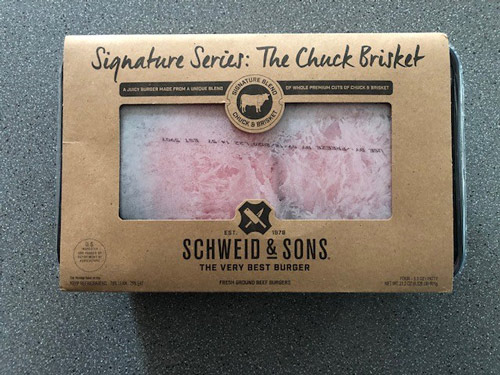
Schweid & Sons chuck brisket hamburger patties. Somehow preformed burgers always work better than the ones we try to build at home whether grilled or pan seared on cast iron. It is hard not to overwork the meat and hard to find beef with a suitable fat content (high) unless you have access to an extremely accomplished butcher who will grind and blend beef to order.
Meat from Schweid, a fourth generation family owned business operating out of New Jersey since 1978 sells nothing but different blends of ground Angus and Wagyu beef, is the next best thing. This one of two cuts tallies 25% fat and never fails to produce a top burger Do, in a reversal of sound practice for roasting beef, keep the discs cold before they hit the fire.
Cobb Hill Cheese in Hartland, Vermont, makes their own exceptional takes on Appenzeller (‘Ascutney Mountain’), Caerphilly (‘Four Corners’), Gouda (“Oh My Gouda’) and rotating seasonal styles. None of them tastes quite like its template, a good thing. The herd of Jersey cows at Cedar Mountain Farm provides all their milk so each cheese tastes discernibly theirs. Available from the Upper Valley Food Coop in White River Junction, Saxelby cheese in the City of New York and online from various sources including Cobb Hill themselves.
Mystic River ‘Melinda Mae’ soft ripened cheese. Another single herd cheese, this one made, appropriately enough with sea salt by Mystic River out of Groton, Connecticut, Melinda Mae has a big personality. The playful description at the Mystic River website is apt: “A pudgy paste of Cultured Cremini Cream caught between a cumulous cloud of mystical mycelium.” Soft and saucy, richer, subtler, better than Brie or Camembert, an American original. Available a specialty shops and farmers’ markets in southern New England.
Big John Cajun Cheese from Beehive Cheese in the high desert town of Farmington, Utah, is, as they describe it, “cheddar elevated to artisanal greatness,” which however describes a true English farmhouse Cheddar equally well. The difference between Big John and its farmhouse model is the coating of Louisiana seasoning rubbed into the surface of the Beehive Promontory Cheddar by its creators in Utah. It is named, of course, for Promontory Point in Utah where the Central Pacific and Union Pacific lines met to form the first Transcontinental Railroad in the United States. They named their Big John variant in turn after John Dearman, a chef in nearby Ogden, Utah, from Louisiana who, the people at Beehave explain, “graciously allowed us to use his rib rub on our Promontory.”
 Kilner jars are the English analog of American Ball jars, equally good for pickling and canning but so much more stylish than the American icon. The swingtop bottles and hexagonal jars with blue gingham lids increase the elegant aura of whatever you preserve by their presence alone. Now widely available online in the United States and even at a few brick and mortar shops. Huzzah for Kilner jars.
Kilner jars are the English analog of American Ball jars, equally good for pickling and canning but so much more stylish than the American icon. The swingtop bottles and hexagonal jars with blue gingham lids increase the elegant aura of whatever you preserve by their presence alone. Now widely available online in the United States and even at a few brick and mortar shops. Huzzah for Kilner jars.
Mole dry salame is an outstanding product from New England Charcuterie in Waltham, Massachusetts, also the home of Gore Place, the finest Federal country house in North America and the rare product of a gifted female architect during the Early National era. The seasoning for the NEC mole includes cocoa, chipotle as well as ghost chili, clove and garlic. The inspiration is obviously Mexican, the execution pure Yankee. As Keith Stavely and Kathleen Fitzgerald have known all along and confirmed in print, we New Englanders have been resourceful cooks since the seventeenth century inception of the original English settlements. The Backroom at Moody’s Delicatessen in Waltham, the producer of NEC products, will offer a lively refuge again once the plague departs New England. The second location in the Back Bay also will be most welcome back. Their porcini salame and salame with Bourbon and bacon are equally good and nearly as distinctive as the mole.
St. John Trotter Gear is simply a sublime, highly seasoned severe reduction of pork jelly. It is hardly original to extoll something St. John but then we were among its very first diners, keep on going and have swapped recipes with the line cooks in the Commercial Road over purchases of bread, Eccles cakes, Cahors and Albarino. You can make your own but the convenience of Gear is irresistible and, for a moment anyway, the home good may bask in the reflected glory of Fergus Henderson &Co. Only, unfortunately, available from the source but then that alone provides an excuse to hurry back to London once the plague exacerbated by BoJo and his fellow clownish cronies finally exits right.
Eccles cakes from St. John Bread & Cheese in Spitalfields or, failing them, just about any Eccles cake at all.
‘English Toasting Bread.’ The McQuade’s Marketplaces in Westerly and Jamestown, Rhode Island, and Stonington, Connecticut bake what the British call a traditional cottage loaf. It is a big squaresided rectangle of robust texture that, as its American name indicates, makes excellent toast. Good value at about $2.50 per pound. British food in America!
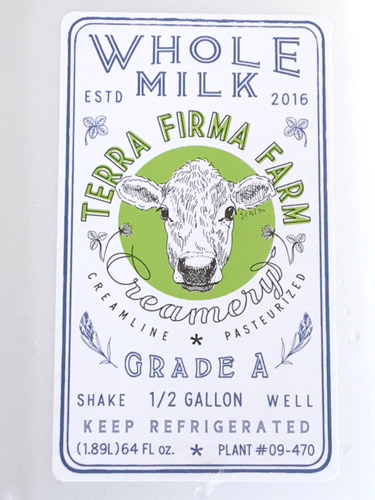 Terra Firma Farm whole milk. The farm describes itself as “a diversified pasture-based livestock and poultry farm”. All the milk and beef comes from grass fed cows; they raise heritage pigs and free range turkeys. The label on the milk includes the instruction to “shake well” for good reason. This is the kind of milk prevalent in Ireland back in the 1970s before the EU enacted regulations requiring uniform butterfat content. Its color is creamy, almost yellowish rather than white; the butterfat content is a lot higher than what now passes for conventional milk.
Terra Firma Farm whole milk. The farm describes itself as “a diversified pasture-based livestock and poultry farm”. All the milk and beef comes from grass fed cows; they raise heritage pigs and free range turkeys. The label on the milk includes the instruction to “shake well” for good reason. This is the kind of milk prevalent in Ireland back in the 1970s before the EU enacted regulations requiring uniform butterfat content. Its color is creamy, almost yellowish rather than white; the butterfat content is a lot higher than what now passes for conventional milk.
If you like half & half in your coffee ignore the instruction and pour yourself the rich topmilk.
Baxters Albert’s Victorian Chutney will not turn heads looking for novelty. Instead it is a classic Scots chutney made predominantly with the apples cultivated there but also with the dried fruits--raisins and dates--along with the citrus, molasses and spice imported into Britain since the seventeenth century. This chutney is more satisfying than showy and not a single artificial or preservative element is anywhere in evidence. Look for it.
Bog standard Nabisco Ginger Snaps are pretty much peerless; ancient, simple, sublime, versatile and cheap. They are made with mercifully few ingredients, most of them recognizable to the 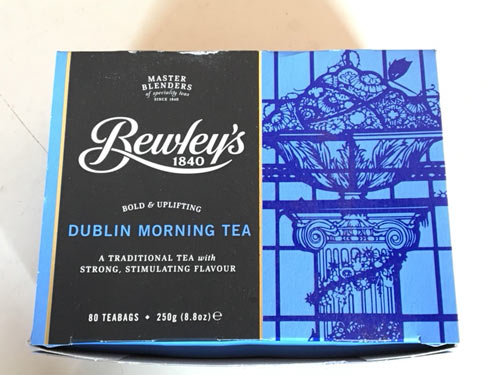 consumer lacking a chemistry degree. Good with fools and syllabubs, cheese and port or porter, whisky and whiskey (Bourbon or Irish) and especially good dark rum. It is, of course, the molasses.
consumer lacking a chemistry degree. Good with fools and syllabubs, cheese and port or porter, whisky and whiskey (Bourbon or Irish) and especially good dark rum. It is, of course, the molasses.
Bewley’s Dublin Morning Tea has an even richer taste than Irish or English breakfast teas. It also has a smoother profile and almost berrylike tone. Outstanding value at about E4.00; slightly but not excessively more expensive in the United States if you can find it.
 Sheridans Irish brown bread crackers are spectacular. Paper thin, brittle with crunch, the best vehicle for any cheese whether hard or soft, pungent or delicate. Sheridans itself is an exemplary Dublin cheesemonger and remarkably impervious to regional rivalry in getting their crackers from West Cork. The crackers are made from wholemeal wheat, buttermilk, butter and sea salt; nothing more. Exemplary. They are stocked by Murray’s cheese, but only the Village outlet, in New York City and at right thinking grocers in Ireland and the UK.
Sheridans Irish brown bread crackers are spectacular. Paper thin, brittle with crunch, the best vehicle for any cheese whether hard or soft, pungent or delicate. Sheridans itself is an exemplary Dublin cheesemonger and remarkably impervious to regional rivalry in getting their crackers from West Cork. The crackers are made from wholemeal wheat, buttermilk, butter and sea salt; nothing more. Exemplary. They are stocked by Murray’s cheese, but only the Village outlet, in New York City and at right thinking grocers in Ireland and the UK.
Privateer Navy Yard Rum from Ipswich, Massachusetts, the revived heart of eighteenth century rum country . Privateer rum is in the main mediocre but not this. One of the more complex rums ever distilled, Navy Yard manages tones both bright and deep, sweet and pungent, spicy but by no means cloying (and this is not that debased member of the family, spiced rum) but also smooth. No bullshit at cask strength or, as they call it, barrel proof and 57.4% abv. An astonishing achievement from an unlikely source.
Yellow Spot whiskey in the robust nineteenth century Irish style nearly died away during the twentieth but happily has returned. Much Irish whiskey--Bushmills Black Bush a notable exception--is insipid and sweet but not this one, comparable in complexity to single malt Scotch without the smoke or island iodine. A better whiskey than the parvenu Midleton at a (somewhat) lower but still steep price.
Green Spot whiskey is good, just not quite as good as Yellow Spot at a lower price. It bears similar if slightly lesser rich and complicated notes and, at a steep $65 or so, nonetheless represents good value for money. Once upon a time in the nineteenth century they made Red and Blue Spot whiskeys as well: We can hope for their return.
Old Pulteney single malt Scotch represents better value still, by far the best malt on the market at around $45 and as a whimsical bonus the neck of the bottle looks like a pot still. The whisky has remarkable depth, lots of honeyed fruit but a trace of peat. From the northernmost distillery on the Scottish mainland but Old Pulteney may be mistaken for a Speyside malt with a bigger body.
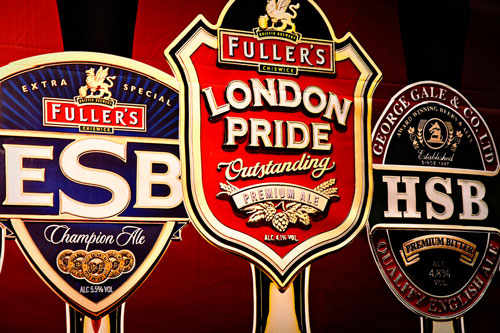 Fuller’s ESB was the prototype for all the extra special variants that have proliferated with the craft beer craze and remains the best, proof that a big legacy brewer may, if it chooses, compete on quality with the most celebrated micros and nanos. A big malt bill and four species of hops makes Fuller’s ESB is richer and more alcoholic than its exemplary pale ale and peerless porter. At 5.9% ABV the ESB strong by Old School English standards, less hopped and maltier than an IPA. The packaging claims the ale is “bursting with marmalade fruitiness throughout” and, against odds, the claim is fair. A wonderful beer.
Fuller’s ESB was the prototype for all the extra special variants that have proliferated with the craft beer craze and remains the best, proof that a big legacy brewer may, if it chooses, compete on quality with the most celebrated micros and nanos. A big malt bill and four species of hops makes Fuller’s ESB is richer and more alcoholic than its exemplary pale ale and peerless porter. At 5.9% ABV the ESB strong by Old School English standards, less hopped and maltier than an IPA. The packaging claims the ale is “bursting with marmalade fruitiness throughout” and, against odds, the claim is fair. A wonderful beer.
Biltong from Jonti Jacobs on Christopher Street in Manhattan comes in several guises. Ignore the sealed packages hanging in racks and accept the friendly attendant’s offer to cut some for you fresh. That way the options multiply; ultralean or a bit of fat, wet or dry, hard or soft in various combinations, all of them exceptional. They make their own South African sausage too, and stock roobiroos tea from South Africa and it packs more punch than the Australian alternative.
Charlito’s Cocina Trufa Seca , in other (English) words dry cured black truffle salami, is produced in Sunnyside, Queens, yet more proof that the borough, or at least Astoria and contiguous zones, is the new Brooklyn. The funk of fermented pork and truffle is pronounced but not overwhelming; earthy, tangy, good.
US No. 1 Premium Idaho Russet Burbank Variety Baking Potatoes distributed by Chelsea Creek Farms at the New England Produce Center in Chelsea, Massachusetts represent a bit of a mystery in a number of ways. Why is a Massachusetts farm importing Idaho potatoes for consumption in the New York metropolitan area? Why don’t they sell potatoes from Maine? They are fellow New Englanders shipping their potatoes entails a smaller carbon imprint. Why does the package lack any information at all about provenance? Are the potatoes actually from Idaho or is the species of potatoes one that only originated there? Why package them in bags of five that weigh in at an equally random 30 ounces? Why do they cost more than bog standard potatoes? And how do they pack so much more potato flavor than the other supermarket potatoes? Available at King’s.
Cotswolds Distillery ‘single malt spirit’ is English single malt, single batch craft whisky by another name. Under British law, the Cotswolds whisky cannot be called that because it only has been aged for twenty months, an insufficient time to earn the name. No matter; the Cotswolds spirit is smooth, but light and bracing rather than rich and smoky notwithstanding its tenure in charred Bourbon barrels. Each label has ten handwritten entries, ranging from cask count and barrel type (red wine in addition to the Bourbon) to bottling date and age, the twelve months that cannot qualify the spirit, technically, as whisky. Search it out.
 “Real Butter Milk” from Katie’s Creamery in Arundel, Maine. It is “not,” as Katie’s proclaims, “made from skim milk” and “contains active yogurt cultures.” It does not contain artificial growth hormones, preservatives (it keeps well enough on its own in any event) or thickeners. This is a robust product, not the watery facsimile foisted on the unwary baker (you biscuits, pancakes and puddings will fail) by the industrial dairies. Buttermilk itself, in the form of traditional buttermilk like Katie’s, is an underutilized ingredient, at least outside the American south. Katie’s could stop that.
“Real Butter Milk” from Katie’s Creamery in Arundel, Maine. It is “not,” as Katie’s proclaims, “made from skim milk” and “contains active yogurt cultures.” It does not contain artificial growth hormones, preservatives (it keeps well enough on its own in any event) or thickeners. This is a robust product, not the watery facsimile foisted on the unwary baker (you biscuits, pancakes and puddings will fail) by the industrial dairies. Buttermilk itself, in the form of traditional buttermilk like Katie’s, is an underutilized ingredient, at least outside the American south. Katie’s could stop that.
Powdered Worcestershire from the franchise spice specialists that have appeared in recent years in any number of small eastern cites, including stunners like Mystic and Newport, is no mere gimmick. The dehydrated sauce is more pungent than its source, which makes sense because drying anything ought to concentrate its flavor, a reduction to essence. Powdered Worcestershire is particularly handy for kneading into chops for cooking in a pan or on the grill; wetter chops do not sear or char as well as dryer ones.
Savenor’s bayou bacon. Savenor’s has been a fixture on Beacon Street in Boston for a long time. Justifiably so; prices can be high but when it comes to cured meat and game the quality and selection are superb. They cure their own bacon, now in including ‘bayou bacon,’ a brilliant notion that ought to have arisen from New Orleans rather than Boston, and a long time ago. The spicing that makes tasso an indispensable ingredient for so many Louisiana ettouffees, jambalayas, smothered dishes and stews lends bacon its own tangy heat. As an added if conceptual rather than culinary bonus, Savenor’s now is the butcher to the Boston Red Sox. There is a Cambridge outpost.
Howe’s Oktoberfest bratwurst claims descends neither from the eighteenth century Admiral Lord nor the Viceroy, but rather from the founders of the Nuremberg firm, Uli Hoeness and Werner Weiss. Contrary to expectations, the company is not that old, dating only to 1985, while the Nuremberger style of sausage itself was recorded in 1313 by the council of the City of Nuremberg, although the first documentation of minced meat (Brat) stuffed into intestine casings does not appear until far closer to our own time, in 1404. Quality control has been an exemplary German obsession since the Medieval period: The 1313 ordinance required the use of pork loin for bratwurst some two hundred years before the celebrated Rheinheitsgebot regulating the constituents of beer, and in the best (or worst) tradition of the guild limited production to particular butchers. The Oktoberfest variant likely violates the fourteenth century decree in its inclusion of beer, proof that, sometimes, an act of subversion signals superiority.
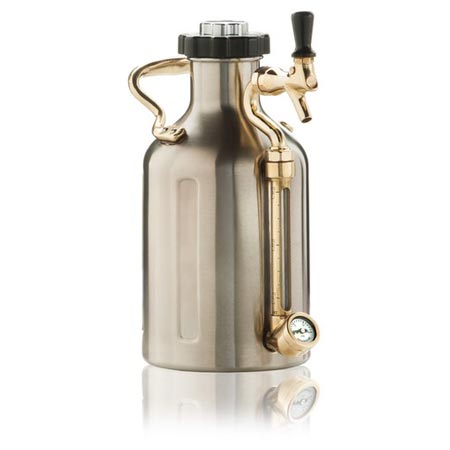 The GrowlerWerks uKeg sounds like something for someone with more money than sense. It is a copper clad growler for the storage of beer. The growler has an analog gauge to display the pressure provided by the carbon dioxide cartridge that fits into a sleeve beneath the cap, which rotates to adjust the strength of the charge. An external pipe with a small locking tap has a long window showing the amount of beer remaining inside. It is a pretty object in a sort of steampunk way and, at about 150 bucks, expensive. A sceptic might be forgiven for wondering why draft beer requires a gassy charge and why anyone would want the contraption when a standard glass gallon jug cost only a few dollars, well less than a tenth the cost of the uKeg. The thing therefore bears the earmarks of an affectation for the pretentious beer snob. In this case, however, its appearance belies the utility of an exceptional product. The problem with taking a growler or howler of beer home is the unfortunate fact that the beer goes flat and stale in very little time. The pressure charge solves both problems and also allows storage of a portion of the beer for a number of days. The uKeg also has a double jacket to keep cold beer cold and therefore fresh in transit. A pretty object that enhances the quality of any life.
The GrowlerWerks uKeg sounds like something for someone with more money than sense. It is a copper clad growler for the storage of beer. The growler has an analog gauge to display the pressure provided by the carbon dioxide cartridge that fits into a sleeve beneath the cap, which rotates to adjust the strength of the charge. An external pipe with a small locking tap has a long window showing the amount of beer remaining inside. It is a pretty object in a sort of steampunk way and, at about 150 bucks, expensive. A sceptic might be forgiven for wondering why draft beer requires a gassy charge and why anyone would want the contraption when a standard glass gallon jug cost only a few dollars, well less than a tenth the cost of the uKeg. The thing therefore bears the earmarks of an affectation for the pretentious beer snob. In this case, however, its appearance belies the utility of an exceptional product. The problem with taking a growler or howler of beer home is the unfortunate fact that the beer goes flat and stale in very little time. The pressure charge solves both problems and also allows storage of a portion of the beer for a number of days. The uKeg also has a double jacket to keep cold beer cold and therefore fresh in transit. A pretty object that enhances the quality of any life.
Rannoch Scottish pressed game terrine consists of pheasant and venison flavored with a drip of olive oil, a little pancetta, some roast shallot and seasonings that include garlic, juniper, parsley, pepper and thyme. The flavor is sublime in the romantic sense; powerful, and extremely good. The terrine is remarkably light, set in pork gelatin instead of fat and the better for that. A 120 gram packet contains two little slabs for the start of a lovely tete a tete.
Falcon pie dishes still are made in Sheffield and that is fitting. They are Old School, enameled steel in rectangular shapes with rounded corners, with a splayed upper ridge ideal for crimping pastry. The material conducts quickly, so even a pie in the oven for a short time will emerge with a crisp browned crust. The white dishes with navy piping around the rim are pretty enough to place on the table to make your savory pie the focal point of a weeknight supper or festive dinner. Available from Labour & Wait as well as online.
Cannon & Cannon British charcuterie. Cannon & Cannon itself does not make anything. The company distributes charcuterie solely from British producers along with a few accessories for use in serving the artisanal products. They also man a retail stall at Borough Market and several smaller markets in England, and operate an online store limited to combination packages. Their aim is the promotion, for profit of course, of high quality companies, a worthy goal that they succeed in executing.
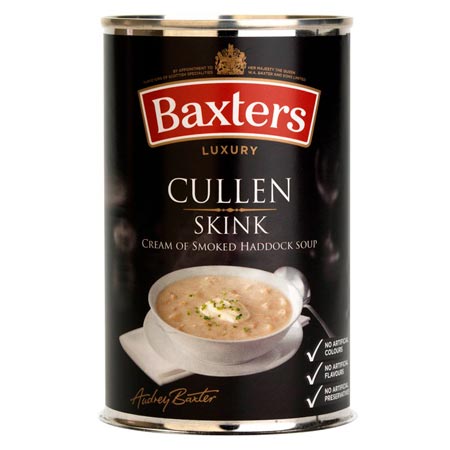 Baxter’s Cullen Skink : Good soup in a can. It is expensive, ten bucks at Meyer’s of Keswick in Manhattan, much less costly of course in the UK, and serves only one, but this may be the best canned soup of any kind on the market. Cullen is a town on the Moray Firth famed for its smoked haddock; skink is Scots for haddock. Even so Jonathan Meades disapproves of the name, of using any place name to describe any dish, as an exercise in manufactured authenticity. At least in this case it is hard to see why. The Baxter’s proportion of fish to potato is good, the traditional seasoning of mace and nutmeg sound. The flavor, at once subtle and robust, would fool anyone. You could pass it off easily as your own.
Baxter’s Cullen Skink : Good soup in a can. It is expensive, ten bucks at Meyer’s of Keswick in Manhattan, much less costly of course in the UK, and serves only one, but this may be the best canned soup of any kind on the market. Cullen is a town on the Moray Firth famed for its smoked haddock; skink is Scots for haddock. Even so Jonathan Meades disapproves of the name, of using any place name to describe any dish, as an exercise in manufactured authenticity. At least in this case it is hard to see why. The Baxter’s proportion of fish to potato is good, the traditional seasoning of mace and nutmeg sound. The flavor, at once subtle and robust, would fool anyone. You could pass it off easily as your own.
Hawthorne Valley Jalapeño Feuerkraut. Most artisanal foods fail to justify their steep prices, but not this product from Hawthorne Valley Farm in Columbia County, New York, an enterprise devoted to anthroposophy, a rather eccentric spiritual doctrine created by the rather eccentric Rudolph Steiner. His doctrine, according to the farm’s website, involves “conscious working with the rhythmical influences of the cosmos.” Whatever their philosophy, the people at Hawthorne Farm ferment an exceptional range of sauerkraut, including this product laced with just enough chili to give the pickled cabbage a little more pungent bite. It is even better than the German sauerkrauts from a jar available at better grocers and infinitely superior to any from a can.
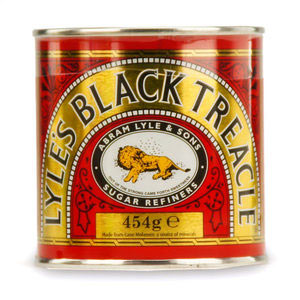 Lyle’s black treacle is, as Rupert Croft-Cooke knew, “an invaluable thing to keep in stock in any case.” Its utility is not limited to sweets. Treacle works its wonder as a marinade for meat and birds, adds a mysterious depth to beef boiled with ale, takes the edge off mackerel to enhance the appeal of an underappreciated fish and works magic when but a dollop graces the suet pastry of a savory pudding, especially iconic steak and kidney (a trick we got from Croft-Cooke). Ubiquitous in the United Kingdom and worth looking for in the United States. In a pinch substitute unsulphered molasses or, better, Steen’s cane syrup from Louisiana.
Lyle’s black treacle is, as Rupert Croft-Cooke knew, “an invaluable thing to keep in stock in any case.” Its utility is not limited to sweets. Treacle works its wonder as a marinade for meat and birds, adds a mysterious depth to beef boiled with ale, takes the edge off mackerel to enhance the appeal of an underappreciated fish and works magic when but a dollop graces the suet pastry of a savory pudding, especially iconic steak and kidney (a trick we got from Croft-Cooke). Ubiquitous in the United Kingdom and worth looking for in the United States. In a pinch substitute unsulphered molasses or, better, Steen’s cane syrup from Louisiana.
Marks & Spencer ‘Simply M&S’ cured ox tongue comes in cheap and handy little 184 gram cans. Tongue, it seems, has become more and more difficult to find, especially in the United States, but even if it were widely available at the delicatessen counter, the M&S canned cured tongue is a good choice for the larder. It may be chilled and sliced or, better, potted with about a third its amount of unsalted butter and a dollop of piccalilli to serve the unexpected guest a welcome starter, snack or sandwich.
Allen’s squash with Vidalia onions. Allen’s canned goods amount to an avatar of the American south. Oddly enough, one of the celebrated Fergus Henderson’s most celebrated and simple British preparations is mushy courgettes (in Britain) or zucchini (in the United States) looks a lot like the Allen squash. The squash from a can of course cannot be as good as Henderson’s but on a busy night represents a reasonable enough facsimile. Be sure to drain the contents of the can with extreme prejudice after cooking and apply lots of butter to the residue.
British Curry from the Teeny Tiny Spice Company consists, presumably in descending quantities, of ginger, black pepper, cardamom, cumin, cayenne, garlic, maple sugar (Teeny Tiny Spice has its base in Vermont) and pink salt. It is, the can claims, “Flavor of the Empire” and the claim is fair. This is an excellent curry powder and no misnomer. As Rupert Croft Cooke has written, curries as we know them are British. Available at Pickwick Mercantile in Portsmouth, New Hampshire, and online from www.teenytinyspice.com .

Fabrique Delices cured duck salami. Unlike a lot of charcuterie that purports to be based on duck but in fact supplements a primarily pork product with a small percentage of the bird, this sausage is made of duck meat alone. The salami includes other ingredients--all salamis do--like, in its case, nonfat dried milk, sea salt, wine garlic and spice, but the flavor of the duck is pronounced and welcome. Unlike many of the other Fabrique Delices offerings, this one is made in the United States rather than Canada. Available at Astoria Bier & Cheese in Astoria, queens, and of course elsewhere.
Savoie’s “Real Cajun!” pickled pork. Barrels of pickled pork once were ubiquitous throughout the nations of Europe and North America as well as onboard their merchant and naval fleets. Outside Louisiana, however, the cured meat has virtually vanished. That is a shame: pickled pork is as handy a seasoning as salt pork, bacon or its pricier Italian cousins including guanciale and pancetta. It is something like a leaner salt pork or pancetta, much leaner, and the essential base for authentic chowder. When nineteenth and early twentieth century chowder recipes specify ‘salt pork,’ they refer to pickled pork, not the fatty descendant now called by the old name. Louisianans season étouffee, jambalaya and many other dishes with pickled pork and it is equally as good as bacon for an Old School Scots curry of rabbit or chicken. Available all over New Orleans and online from www.cajungrocer.com .
Baxters Spicy Parsnip Soup. Baxters makes good soup and tis is one of the better ones. It is unlaced with artificial anything, no “colours, flavours or preservatives.” The spicy reference is to the Raj, a combination of just enough bay, cayenne, coriander, fenugreek, ginger, pimento (probably allspice) and turmeric to give the parsnips and their consorts of carrot and onion a lift. No resort to somebody else’s curry powder for Baxters, and no heavy hand. The soup is vegetarian and none the worse for that.
Brodo Hearth Broth from the Brodo booth on East 12th Street in the city of New York. It would be difficult to describe the intensity of this broth, a difference of magnitude akin to a comparison of ghastly ‘lite’ beer and a 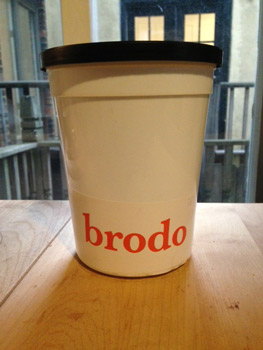 muscular IPA from, say, Deschute, Victory or Yard’s. The visuals, however, give it away: People line up at the booth even in the rain sleet or snow, as hardy a cohort as the postal service used to claim it was. Brodo is viscous rather than wobbly but packs the punch of a jell. A number of different broths are available, the Hearth Broth the most complex, made from beef bones and shin, whole hens and extra chicken feet, turkey legs, a smatter of vegetables and some bay. Worth a trip and worth the wait.
muscular IPA from, say, Deschute, Victory or Yard’s. The visuals, however, give it away: People line up at the booth even in the rain sleet or snow, as hardy a cohort as the postal service used to claim it was. Brodo is viscous rather than wobbly but packs the punch of a jell. A number of different broths are available, the Hearth Broth the most complex, made from beef bones and shin, whole hens and extra chicken feet, turkey legs, a smatter of vegetables and some bay. Worth a trip and worth the wait.
Rhode Island chowder from St. Clair Annex in Watch Hill, Rhode Island. Rhode Island chowder is clear, and instead of rendering it insipid, the absence of cream, milk or tomatoes concentrates the funky concatenation of clam and the essential salt pork. You can buy chowder that is richer than St. Clair’s, has more ingredients or a high proportion of clams, but you cannot buy a better one. This is the best of New England, Old School comfort food born at sea off the Georges Bank.
Pilgrim Joe’s Clam Chowder will not make anyone forget the chowder from the Annex, but as canned soup goes it is good. The principal ingredients of most canned chowders are water followed by potatoes. The principal ingredients of this Trader Joe’s product are clams and clam juice, which speaks at volume. A handy larder standby.
Alheira bread sausage represents one of the more felicitous unintended consequences of a sadistic program. During the Inquisition in Portugal, cruel zealots identified Jewish people to persecute by the absence of sausages hanging to dry from the rafters of their houses. To escape the tender mercies of the Catholic church, Portuguese Jews began making their own sausages, from bread flavored with various meats and poultry instead of pork. Eventually, Portuguese Christians adopted alheira (from the Portuguese alho, or garlic) as their own, returning pork to the bready mix. The sausages resemble a sort of reconstructed sandwich or robust, savory bread pudding; sustainable too in their reliance on lots of bread and little meat. Wonderful.
Sean Brock’s barbecue sauce. Brock is the celebrated owner of Husk, and perhaps the global chef of the moment. He twists traditional southern foodways to create imaginative mutations of heirloom dishes without resorting to gratuitous ingredients or questionable technique. His barbecue sauce is a refinement of the stick red stuff from a jar, lighter, less sugary, a lot more complex and appealing. The recipe, unlike some of Brock’s preparations, is straightforward enough. To make it, just dump together 2½ cups cider vinegar, half a cup of pork stock, ¾ cup ketchup, 1 Tablespoon lemon juice, 2 Tablespoons brown sugar, ¼ teaspoon cayenne, ½ teaspoon garlic powder, ½ teaspoon onion powder, 1 Tablespoon smoked paprika, ½ teaspoon black pepper and ¾ teaspoon coarse salt (like Maldon) in a heavy pot, bring the sauce to a boil, lower the heat to a simmer and reduce the sauce to 1/3 its original volume.
Spice Islands onion powder is incomparable. Onion powder is handy for all kinds of things and Things, including Sean Brock’s barbecue sauce, stewed summer squash, jambalaya, soups, English stews and savory pies. The Spice Islands onion salt is equally good.
Cowboy Ketchup from Rhode Island of all places. The self-appointed food police scoff at any use of ketchup, but the condiment indisputably enhances meatloaf, scrambled eggs, burgers…. Even a stickler for quality like Sean Brock uses it, to make his exemplary barbecue sauce. Cowboy Ketchup is the best of the sweetened tomato ketchups on the market. In addition to the usual suspects of tomato, vinegar and sugar, Cowboy Ketchup contains garlic, lime, molasses, mustard and Worcestershire but, happily, none of the dreaded high fructose corn syrup.
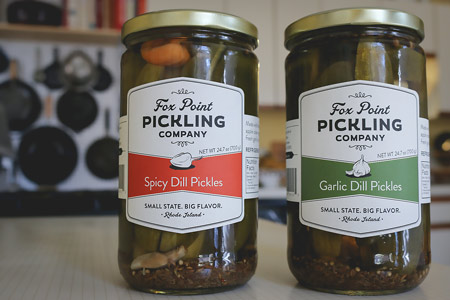
Pickles from Fox Point Pickling Company come in two iterations, ‘Spicy Dill’ and ‘Garlic Dill.’ In fact they share the garlic; the only difference between the two is the whole Scotch Bonnet chili plunked into each jar of the spicy version so, beware, ‘spicy’ is a colossal understatement. These are extremely good sour pickles and if they are made in Warren, Rhode Island rather than the traditionally Portuguese quarter on the East Side of Providence, the branding is sound enough.
Lower sodium oyster sauce. Oyster sauce is sweet and saline, a thick, savory seasoning that wreaks magic with stir fried greens. It would appear counterproductive to create a low sodium version of the stuff unless, that it is, you lack imagination. If you need to reduce the salt content of oyster sauce but retain its tang, what should you do? You should increase the proportion of oyster to salt, and that is what Oriental Mascot oyster sauce has done. The oyster exceeds the salt, in contrast to other oyster sauces, to exemplary effect. This is that rare culinary occasion where something ‘lightened’ is better than its model.
 The two quart Revereware pot. Revereware ranks as an American culinary icon, not necessarily a good thing given our past predilection for jello salad, tuna casserole and the like. Pots from Revere are relatively cheap, made from relatively lightweight stamped steel, if at least garnished with their signature copper base. These are items infra dig to the culinary cognoscenti. The two quart entry in the line also represents one of the handiest kitchen tools. Because it is not a heavy pot it leaps fast to the boil, so it is ideal for cooking “boily bag” rice, Saugy’s hot dogs or steamed green vegetables for two on a busy weeknight. The lid has a cold black handle, the handle to the pot itself never gets too hot to handle with the naked hand and conduction is even, even if alarmingly fast. Who could ask for anything more? We could ask for decent quality in the line’s contemporary incarnation, which is not forthcoming from the cynical purchasers of Revereware, who manufacture a debased impression of the pots in Asia instead of the United States. Go to ebay to get something old.
The two quart Revereware pot. Revereware ranks as an American culinary icon, not necessarily a good thing given our past predilection for jello salad, tuna casserole and the like. Pots from Revere are relatively cheap, made from relatively lightweight stamped steel, if at least garnished with their signature copper base. These are items infra dig to the culinary cognoscenti. The two quart entry in the line also represents one of the handiest kitchen tools. Because it is not a heavy pot it leaps fast to the boil, so it is ideal for cooking “boily bag” rice, Saugy’s hot dogs or steamed green vegetables for two on a busy weeknight. The lid has a cold black handle, the handle to the pot itself never gets too hot to handle with the naked hand and conduction is even, even if alarmingly fast. Who could ask for anything more? We could ask for decent quality in the line’s contemporary incarnation, which is not forthcoming from the cynical purchasers of Revereware, who manufacture a debased impression of the pots in Asia instead of the United States. Go to ebay to get something old.
Justino’s Rainwater Madeira is difficult to find outside Rhode Island and southeastern Massachusetts now that the once indispensable Ferry Liquors has departed Ferry Street in the Newark Ironbound for environs perpendicular on the presidential streets and become the faintest wraith of its former self. We continue to extol the value of Cheap Fake Madeira but now have found something better, Cheap Real Madeira. To our unpatrician taste anyway, this wine is about as good as any Rainwater not bottled by the Rare Wine Company. At about $13 a bottle the Justino Rainwater runs about twice the price of superior Cheap Fake Madeira (aka Paul Masson) but Justino is cheap enough and has elements of Madeira complexity that the counterfeits lack.
Power Greens from NewStar in Salinas, California are a mix of spinach, young bok choy and green and red chard. They come washed and bagged, cook in only two or three minutes with olive oil and taste good. A bizarrely apportioned 13.25 ounce bag should serve two.
Billington’s dark brown molasses sugar is grown on Mauritius, a tiny island of distinctive foodways; packed in Liverpool, one of the storied ports of history; and distributed in the United States through Sugar Land, Texas, an inadvertently apt location. For a change the blurb on the packaging describes precisely what you get, “a soft, moist, fine grained sugar.Rich in natural molasses, it has a deep brown colour and distinctive toffee flavour.” The best of all brown sugars we have encountered.
Chicken of the Sea smoked salmon packets. These small packets require no refrigeration and boast a shelf life of at least three years, possibly perpetuity. They will not cause anyone amnesia for genuine Scottish smoked salmon sliced paper thin from the filet and it would be inadvisable to eat them straight from the metallic envelope. Their cost, however, is a fraction of the real thing and that shelf life renders them a handy larder staple because it turns out the product makes a quick and much more than passable potted fish for service as an elegant appetizer or sandwich filling. If they lack the universal utility of cheap fake Madeira, the salmon packets fill their niche role with aplomb. About three bucks for three ounces, which is enough to puree potted salmon for two; a recipe appears in the practical .
Ducktrap River Maine Smoked Shrimp come in 8 ounce tubs. The shrimp are tiny and smoky, useful for making shrimp sauce to pair with any finfish or for potting in the traditional manner. Unlike canned cocktail shrimp they are neither mucky nor unpleasantly fishy. They are not unpleasant at all, and have a decent enough shelf life in the refrigerator. No preservatives or other chemicals, no high fructose corn syrup or other intruders, just the shrimp smoked with fruitwood, hardwood, salt and a drip of evaporated cane syrup. An excellent product.
Tupperware compact colanders do not appear to be in production any longer, a mystifying development given the ingenious design. The colander holds two cups. Its perforated base is flat for stability and stands on a short scalloped footing to facilitate drainage. It is smaller in circumference than the top, which includes a lip on one side and, next to its handy handle, a notch on the other for securing it to the rim of a bowl without slippage. The bowl itself is a partial cone, concave on the handle side to avoid spillage and convex on the other to provide a snug fit within a bowl. The design is so superior to the tradition semispherical screen that its discontinuation, and the fact that it apparently never appeared in a larger size, remain mystifying. Fortunately quite a few of them show up with regularity on e-bay and other secondary sale sites.
Coastal Cheddar from Ford Farm in Dorchester. The creamery stands between the Dorset Downs and Jurassic Coast on a world Heritage Site. Its Cheddar my not be as famous as Montgomery and others, at least not yet, but its flavor is just as good and its texture is fascinating. The texture is almost gravelly in a pleasant way, the result, according of the Ford Farm website, of “calcium crystals which form naturally in the cheese once it has reached its optimum maturity. Listen closely” while you chew, as the farm advises, “and you just might be able to hear the sea.”
 Funnels. If you make infusions, whether of vinegar, oil or alcohol, a funnel is essential. If you ever fill a flask or two or more, you want a full to prevent spillage. If you transfer any liquid from any larger to smaller container, for that matter, a funnel facilitates the task. Funnels are cheap and handy.
Funnels. If you make infusions, whether of vinegar, oil or alcohol, a funnel is essential. If you ever fill a flask or two or more, you want a full to prevent spillage. If you transfer any liquid from any larger to smaller container, for that matter, a funnel facilitates the task. Funnels are cheap and handy.
Deanston un-chill filtered Highland Single Malt Scotch Whisky will not cause anyone to discard her Glenfarclas, Glenmorangie Madeira or Royal Lochnagar but at under $30 a bottle it represents extreme value. Far more than adequate to mix a distinctive Whisky Mac with ginger wine and just good enough to sip on its own.
S. Clyde Weaver hot dogs , or, as they call them, German garlic sausage. We previously have applauded the survival of distinctive regional hot dogs in the United States, and Weaver makes a good one, longer and thinner than most dogs. The company is located in Lancaster, Pennsylvania and also sells its products at farmers’ markets in eastern Pennsylvania (but, oddly only around rather than in Philadelphia. Also available online but shipping is pricey.
Wyman’s wild blueberries in water are canned in Maine. Mainers tend to be direct, brutally honest in fact, and for once the advertising blurb a company puts on its product is something a buyer can trust. “Wild blueberries have grown naturally for thousands of years in the coastal fields of downeast Maine. They are different from cultivated blueberries in that they are smaller in size, more intense in color, are firmer in texture, and have a sweet and tangy taste.” All true, and the canning process only intensifies the flavor. Drain and save the juice from the can before cooking with its contents. Wyman’s blueberries make an excellent fool, simmered with a little tawny Port, a stick of cinnamon and a burp of golden syrup before mixing with a swirl of heavy cream. Cans can be our friends.
 Buffalo wings at the Thirsty Moose in Portsmouth, New Hampshire. The kitchen keeps the wings intact in their boomerang planform instead of splitting them like everyone else, bakes and bastes them in its own sauce and then chars them over direct fire. These wings are so good they taste like a substance altogether different from workaday bar Buffaloes. The bar itself has hundreds of beers on tap, most of them from craft or nanobrewers, many of them local. Alone worth the trip to beautiful Portsmouth but there is so much more to see.
Buffalo wings at the Thirsty Moose in Portsmouth, New Hampshire. The kitchen keeps the wings intact in their boomerang planform instead of splitting them like everyone else, bakes and bastes them in its own sauce and then chars them over direct fire. These wings are so good they taste like a substance altogether different from workaday bar Buffaloes. The bar itself has hundreds of beers on tap, most of them from craft or nanobrewers, many of them local. Alone worth the trip to beautiful Portsmouth but there is so much more to see.
Sierra Nevada lip balm. Throw away the Chapstix. Sierra Nevada has infused its balm with citrusy hops and managed to eliminate the awful waxy texture of the competition. Good value at only a buck a tube; available online direct from the ‘brewer.’
Schaller & Weber ‘pâté with truffles’ that is really liverwurst will set you back only something like $6 for a seven ounce tube. How do they do it at the cost when the taste of truffle blasts right through the rich pork and liver? They use ingredients of a high order, in descending quantity pork, its liver, truffles, truffle oil, even Turbinado sugar, spices, celery, onion and a hint of actual rather than artificial vanilla. Ridiculous.
Oatcakes. Nairn’s oatcakes, Walker’s oatcakes, oatcakes coarse and oatcakes fine, any oatcakes are difficult to beat.  They are simple, healthful and versatile, platforms for jam or marmalade, smoked salmon or trout, British cheese and apples, any cheese at all. The texture and flavor are uniquely Scottish and uniquely good.
They are simple, healthful and versatile, platforms for jam or marmalade, smoked salmon or trout, British cheese and apples, any cheese at all. The texture and flavor are uniquely Scottish and uniquely good.
Baxter’s Cullen Skink. Soup from a can may often merit comparison to ‘used’ dishwater. Not this. Baxter’s makes some decent soups; this is not one of those, it is better than that. It consists of little more than good smoked haddock, firm enough potatoes, butter, cream and milk, nothing much more; no colorings, guar gum, polysorbate 80, strontium 90. That is how this archetypal Scottish soup should be, and if a restaurant put it on your table you would never know it emerged from a can.
Macsween’s haggis. We like haggis, a lot, and like, untraditionally, to remove it from the casing, mash it into a small cast iron skillet and bake it with eggs set in craters on the surface. Macsween’s is the gold standard for haggis and unfortunately, for Americans, sold only fresh and banned in the United States due to the perversity of the FDA. Nobody here told anyone how simple and harmless it is to slip a haggis or two in the luggage.
Canned haggis is not Macsweens but is not bad. The Caledonian brand made in Texas is (obviously) legal in the United States, and not too bad, but lacks the proportion of offal a haggis ought to have. British brands are better but even canned British haggis is banned in the United States. Grant’s is good; Baxter’s better. Unlike some American imitators, both brands always are made with lamb.
Sons of Liberty ‘Uprising’ malt whiskey. A limited release, Uprising is distilled from local ale instead of water and malt. The fermentation stage seems to add a depth of flavor and indescribable nuance to the whisky. In a blind tasting you might think you have stumbled across an undiscovered single malt that would be hard to place in one of the legendary Scots whiskey regions; Speysade, perhaps, or Highland but not quite right, because Sons of Liberty comes from Peacedale, Rhode Island. The personable proprietors have distilled something with a heady and unique appeal. Impossibly smooth too.
 Lagunitas Sucks “Brown Shugga Substitute Ale”. Au contraire, Lagunitas Sucks does not in any way suck. It is a near perfect balance of hops and malt, a big, nuanced West Coast IPA. Not as hot on the tongue as Lagunitas Little Sumpin’ Sumpin’--possibly lower in alcohol as well. We wish we could find more, and more, and more, but it is a limited edition, only available seasonally.
Lagunitas Sucks “Brown Shugga Substitute Ale”. Au contraire, Lagunitas Sucks does not in any way suck. It is a near perfect balance of hops and malt, a big, nuanced West Coast IPA. Not as hot on the tongue as Lagunitas Little Sumpin’ Sumpin’--possibly lower in alcohol as well. We wish we could find more, and more, and more, but it is a limited edition, only available seasonally.
The notes from the brewer that appear on the bottle describe the creation of the beer:
“E.K. Ross* would have enjoyed our suffering in 2010 when we saw we couldn’t brew our Brown Shugga. But in that time of deepest despair, as is common to artists everywhere, . . .broke, hung over, abandoned by the muse and prepared to take a job at Arby’s, we found in that darkness the spark of inspiration that would yield up this nearly sanctified recipe.”
*(who wrote On Death and Dying in 1969--we at BFIA had to look it up.)
Batchelors Curried Beans, or, ‘Baked Beans in a Curry Sauce.’ The global reach of curry even has infiltrated the Yankee bean, via Ireland of all places. These cans hardly contain anything that will turn the head of a Brooklyn locavore, but do harbor comfort food with more than a flash of spark. A guilty pleasure, perhaps, but nothing to cause even the merest blush of shame.
Spencer’s pork and herb bangers. We cannot know which herbs because, other than  parsley, the label does not say. Other than that, it would be difficult to criticize anything about these traditional British sausages made in Chicago. The taste and texture of cereal
parsley, the label does not say. Other than that, it would be difficult to criticize anything about these traditional British sausages made in Chicago. The taste and texture of cereal  (breadcrumbs) is just noticeable, and that is good; it is a style abused by fillers in Britain and nearly unknown in the United States. These sausages possibly are the best of their kind we have encountered anywhere. And we have no doubt from the flavor that sage and other things greenish represent those anonymous herbs.
(breadcrumbs) is just noticeable, and that is good; it is a style abused by fillers in Britain and nearly unknown in the United States. These sausages possibly are the best of their kind we have encountered anywhere. And we have no doubt from the flavor that sage and other things greenish represent those anonymous herbs.
Granny Mary’s potted beef made, the producer proclaims, with British prime beef and clarified best butter to a recipe from the 1920s. A good balance of spice pulls up the rich flavor of the beef to more than back the boasting. A superb and inexpensive treat; the people at Granny Mary’s, or rather ‘Original Recipes, the actual name of the Derbyshire company, deserve our gratitude for keeping alive a neglected British tradition of potted foods. The beef is their only product but the company website indicates that plans are afoot for chicken with ham hock, duck with orange zest, and venison with port and blueberries,
Pastene ‘Madeira.’ The editor is pleased to report the discovery of a good new Cheap Fake Madeira. This one is the driest yet, but the concomitant to a nice astringent tang is some diminution of the distinctive if elusive Madeira flavor. This one ranks second in line to Paul Masson in the CFM pantheon.
Corte’s Alheira , which the producer describes as “Portuguese Brand Bangers (60% Bread)” really amounts to an Old School English style pudding. Most of the remaining 40% is pork according to the label, which does not disclose how delightfully smoky the pudding turns out to be. This is a satisfying treat for a straitened age in which we all worry about sustainability and carbon footprints. But beware; unless you are careful the ‘banger’--for there is a pudding big enough for two people in each package--will explode. No particular harm would be done, but go conservative and steam the Corte product over the most gentle heat.
Lost Vineyards ‘Rosso Italian Red Wine.’ Granted not a promising name, the vinous equivalent of the round circle. The suspicion of curious people will increase with disclosure of the price: $3 or $4, not a typographical error. The Lost wine does not pack much alcohol for a red rosso; that, the lack of a vintage date and its screwcap, may in part explain the price. But take a closer look; the wine is 100% Sangiovese, the great grape of Chianti. We can have no idea where the grapes were grown, because the label does not tell us, and our Lost friend will not fool aficionados of a true Tuscan Classico. It does, however, taste of Sangiovese, and tastes better than modest blended Chiantis costing multiple more. A good winter wine and a minor miracle.
Bar Harbor All Natural Smoked Wild Kippers are not, it transpires, fished off the coast of Maine. The trawlers do, however, sail into the Gulf of Maine, if from Canada. Elsewhere the Editor has bemoaned the absence of (uncanned) kippers from America, but these are a more than reasonable facsimile, packed in water instead of oil so you can drain them, dry them, and roast them under the broiler for a moment or five. Suitable even for kedgeree; unlike much in the world of delectable canned fish, the Bar Harbor kippers do not overwhelm the flavor of cooked compatriots.
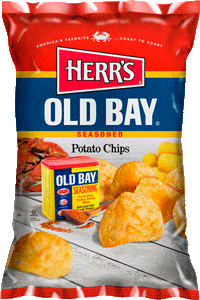 Herr’s Old Bay potato chips. An ingenious idea well-executed; dust potato chips with the piquant seasoning from Baltimore. Even more addictive than other chips.
Herr’s Old Bay potato chips. An ingenious idea well-executed; dust potato chips with the piquant seasoning from Baltimore. Even more addictive than other chips.
Penzey’s Balti Seasoning. As diligent readers will know, the editor is no snob when it comes to curry powder in its myriad manifestations. It is well and good to roast, grind and combine your own spice, but not at 10 pm on a workaday weeknight. This curry powder from the reliable Wisconsin herbalist (outposts in Oak Park aside Chicago, Grand Central Terminal in New York City and who knows where else) by another name is particularly delicate in a happy way. A blend, we are told, of coriander, garlic, ginger, cumin, dundicut*, chilies, cinnamon, cardamom, mustard. Clove, fenugreek, anise, nigella*, ajwain, cilantro and bay, presumably in declining proportion.
*Dundicut is a species of Pakistani chile; nigella, or its seeds, are more commonly called black cumin; and ajwain is a relative of carroway. Penzey’s likes to tease us.
Waitrose Organic Mixed Spice. Every British herbalist, from the commanding heights to the stinking abbatoirs in terms of quality, sells a blend of spices that harkens back before the seventeenth century. The mixed spice from Waitrose includes, presumably in diminishing proportion, coriander, cassia, ginger, nutmeg, caraway and cloves. It stands at the top of the hierarchy, a pleasing combination of good quality ingredients. Mixed spice is not just for baking (for which it is quite good) but also enhances savory dishes, and especially raised pies.
Talk o’ Texas Okra Pickles. No trace of slime here. Instead, bite into a crisp pickle perfect for preceding foods of either India or the American south. A good gateway for reluctant samplers of okra; nothing to intimidate the least adventurous diner here. Mild or hot versions available; your choice but the chili does tend to overtake the delicate vegetable.

Milk from Wildowsky Dairy in Lisbon, Connecticut. This is, we had thought, the stuff of lost legend. The milk is so rich and creamy that you may find a welcome clot of cream itself plugging the neck of the plastic jug. The Editor had tasted nothing like it since 70s Ireland, before the baneful edict of the EU required watering all milk to a uniform, and diminished, fat content. The milk has never encountered an antibiotic or hormone but the texture and taste trump its other attributes. The Wildowskys really do inhabit a wayback machine: They even offer delivery door to door.
Prather Ranch biltong. Biltong, for the uninitiated, is a cured and dried meat found in southern Africa and the Indian subcontinent. There it usually is made with hooved game; Kudu is an exotic example from Zimbabwe. The people at Prather Ranch read about it, decided to make some and pulled a recipe from the internet. They use beef rather than an ungulate, and cure it with brown sugar, black pepper, spices, baking soda and vinegar to good result. The flavor is complex and slightly gamey, the texture not nearly as dry or tough--it is not at all tough--as jerky. Prather Ranch maintains a booth at the estimable Ferry Terminal Market in San Francisco, and although the company cures and dries its biltong elsewhere, Prather actually has a base in the city. They also sport the coveted ‘Praise the Lard’ logo.
D’Oliveiras Malvazia Madeira. A strange and wonderful five year old malmsey purchased on the volcanic island itself, this is a sweet-tart wine with nuances of note even by the standards of Madeira and an unexpectedly exceptional mate for sharp pimiento cheese on toast, the estimable standby of the American south. Then again lowcountry magnates drank sweet(ish) Madeira with just about anything in their eighteenth century heyday, and why should we not follow suit? Get some if you can; it is hard to find. But beware; this is winemaking of the Old School, and D’Oliveiras Malvazia throws a lot of sediment, so store it upright the way our forebears did and keep a paper filter and funnel handy
Creminelli whiskey salami is fine product that took an unlikely journey to the editor’s table, from Charleston, South Carolina via Salt Lake City and Britain, after all the birthplace of whiskey. How did an artisanal Italian maker of charcuterie land in Utah and decide to craft a decidedly un-Italian sausage in bigoted Salt Lake rather than benign Park City? It is, as Chief Judge Posner might say, a puzzle. But perhaps we digress. Creminelli’s Barolo salami, a funk bomb with considerable appeal, is a fellow Thing We Like. This hard, dry cured sausage shares most ingredients with the sausage laced with Barolo, but the whiskey gives it an unexpected flavor; subtle as opposed to stinky, barely smoky and utterly irresistible. Also insanely expensive at goat.sheep.cow. in Charleston at $45 a pound plus tax when it will set you back a lot less online--if they have it--straight from www.creminelli.com for $28 a pound plus ten bucks shipping on any tonnage; shame on goat.sheep.cow. for capitalizing on the feeding frenzy that is Charleston.
 Fuller’s London Pride will not be mistaken by anyone for an American craft ale or one of the newer British beers. It contains relatively little alcohol (4.7% ABV), only hints at its hops and tastes subtle, even mild. This is an unfashionable Old School beer that is wonderful in the bottle and much better on draft. Unlike the big American ales and IPAs, Pride is all balance; the elegant and yet light texture of its malty tones offset by a cidery finish is a minor miracle, so much refreshing flavor pulled out of so little alcohol. Even its graphics are good, a study in classic London sans serif. It comes from the last of the old London brewers Fuller, Smith & Turner, who still make all their beer at the original Griffin Brewery in Chiswick. Even the name evokes tradition.
Fuller’s London Pride will not be mistaken by anyone for an American craft ale or one of the newer British beers. It contains relatively little alcohol (4.7% ABV), only hints at its hops and tastes subtle, even mild. This is an unfashionable Old School beer that is wonderful in the bottle and much better on draft. Unlike the big American ales and IPAs, Pride is all balance; the elegant and yet light texture of its malty tones offset by a cidery finish is a minor miracle, so much refreshing flavor pulled out of so little alcohol. Even its graphics are good, a study in classic London sans serif. It comes from the last of the old London brewers Fuller, Smith & Turner, who still make all their beer at the original Griffin Brewery in Chiswick. Even the name evokes tradition.
Boccalone orange & wild fennel salame. This one is a fermentation bomb run wild to the point of pungency. You catch, then lose, and discover again the faint citrus notes through some heavy, meaty funk; it may not be for the faint of heart but for the rest of us this is a sausage to devour.
Rhubarb spice cake. Is there a crop more characteristically English than rhubarb? Does any people traditionally enjoy baking with ‘mixed spice,’ a combination in various combinations and proportions of allspice, caraway, cassia, cloves, coriander, ginger, mace and nutmeg, more than they do? Does anyone bake a better rhubarb spice cake than Farmstead in Providence, Rhode Island ? Theirs is a moist balance of fruit and spice, equally good for breakfast, with cheese, or accompanied by your choice of Madeira or Port. If you answered ‘no’ to all three questions, then you bask in the comfort of knowledge that you are a discerning epicure.
Scott’s Barbecue Sauce. A definitive North Carolina style cayenne and vinegar based baster. A jar of it and a shoulder of pork are all you need to produce addictive pulled pork; simmer them on the lowest conceivable heat for ages until the meat collapses into itself. The sauce is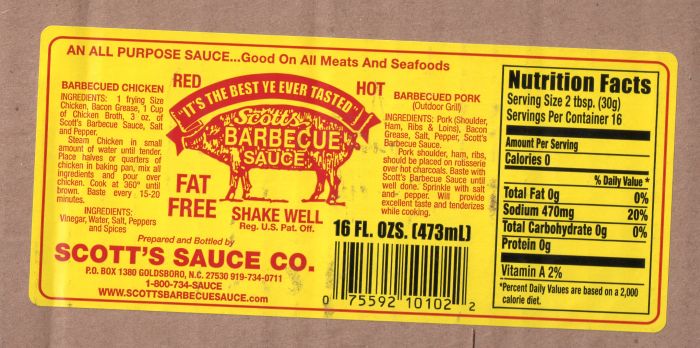 miraculous; its ingredients include nothing but vinegar, water, salt, peppers and spices in order of relative quantity. No calories, none at all, zero, create a world of flavor. They obtained a patent on it in 1946, quite a feat for a foodstuff; quite a find at only about two bucks a pint. Available direct from the producer at www.scottsbarbecuesauce.com .
miraculous; its ingredients include nothing but vinegar, water, salt, peppers and spices in order of relative quantity. No calories, none at all, zero, create a world of flavor. They obtained a patent on it in 1946, quite a feat for a foodstuff; quite a find at only about two bucks a pint. Available direct from the producer at www.scottsbarbecuesauce.com .
Taste #5 Umami Paste. It comes in a tube like anchovy paste and the resemblance is more than superficial; #5 has an effect on sauces and stews like the fermented fish on steroids. The paste is made in Italy of Mediterranean staples; anchovy, garlic, black olives, Parmesan, porcini, tomato paste, vinegar, salt and sugar. It also amounts to a reinvention of classic English seasoning and, before anyone scoffs, was formulated by the owner of (an admittedly Italian) restaurant in London. Anchovy, garlic, Parmesan and porcini (called penny button mushrooms in the past) in particular have added savor to English dishes for centuries. The antecedents of #5 include Gentlemen’s Relish, mushroom ketchup, Worcestershire and myriad lost additives like Harvey’s sauce. Not in the least unreasonably priced at about six bucks for a two and a half ounce tube that will last some time.
 Field Notes. The Editor is as addicted to her IPhone as any tween (it’s nice to know the temperature anywhere at any time) but nothing beats a notebook for trapping inspiration on the fly. You can scribble sketches too. The imprints on Field Notes are fun, with their ironic suggestions for use. They are the right size at 5x3 inches, big enough to contain complete thoughts and sufficiently discrete for, say, a restaurant critic. And they come in custom editions too: ‘Defend New Orleans’ or a celebration of Louisiana with surprising state statistics (“STATE SOIL: Ruston (unofficial)”) are only two, if of the best.
Field Notes. The Editor is as addicted to her IPhone as any tween (it’s nice to know the temperature anywhere at any time) but nothing beats a notebook for trapping inspiration on the fly. You can scribble sketches too. The imprints on Field Notes are fun, with their ironic suggestions for use. They are the right size at 5x3 inches, big enough to contain complete thoughts and sufficiently discrete for, say, a restaurant critic. And they come in custom editions too: ‘Defend New Orleans’ or a celebration of Louisiana with surprising state statistics (“STATE SOIL: Ruston (unofficial)”) are only two, if of the best.
Buttermilk crullers from the Koffee Kup Bakery in Burlington, Vermont are welcome survivors. Once crullers were as common to New England as, well, doughnuts themselves. Now that even Dunkin’ Donuts has stripped its shelves of the twisted tubes, however, they are hard to find. The ones from Koffee Kup are wonderful: “A family tradition since 1940.”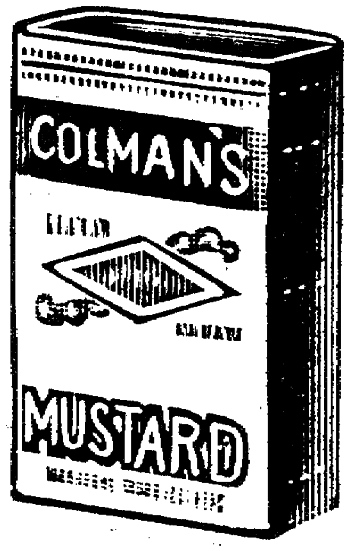
Colman’s mustard in 50 gram tubes is a traveler’s friend. They are small enough to carry onto aircraft with your liquid toiletries in that plastic quart bag and keep without refrigeration better than jars once opened, and Colman’s itself is a classic of plain English excellence.
Bittercube Barrel Aged Blood Orange Limited Batch Bitters can travel too. Such a big if pleasantly alliterative name covers a small bottle of only an ounce. The cap is armed with a dropper so you will neither waste nor overdose the precious juice. At about $10 apiece these bitters are not cheap but the flavor is huge so an ounce will last a while. Available at Binney’s in Chicago.
Somerdale English Cheddar cheese with wholegrain mustard & ale. Granted a guilty pleasure, this is industrial dairy but oddly appealing anyway. The texture is unsuitable soft but for the crunch of mustard and the flavor is good. A good break from the equally infra dig but essential American cheese food product slices for making grilled cheese. While we squat in the confessional, there once was a curry infused Cheddar at the outdoor market in Eastleigh outside the great and grubby port of Southampton that we surreptitiously scarfed too.
The Newton Prep Master cutting board. It is hard for the Editor to get excited about cutting boards except in the wrong way when confronted with the purportedly hygienic but ghastly plastic or nylon impostors. This one merits mention, however, for the slideout metal pan that catches juices from your roast. Why has no one dreamed this up before? Did the John Boos Collection a patent for the things? The hardwood boards come in various sizes, none of them cheap starting at about $140; widely available online. Hard to clean with any aplomb but you will find a way .
Old Bay seasoning. A bandwagon today supports Old Bay. Brooklyn chefs,domestic other hipsters us and us turn to the bullish blend for spicing everything from seafood to salads for good effect. None of this should distract anyone from the notion that it has been a traditional standby for home cooks along the eastern seaboard of the United States from the Chesapeake all the way through northern New England.
Jacobs Cream Crackers. Orwell has a lot to answer for in terms of his writing about English food, but he did get something right. He considered English commercial crackers, or biscuits, one of the enduring glories of the table. One type, Jacob’s Cream Crackers, does not in fact contain any cream, but the flavor of these crispy chewy delicate crackers more than justifies the marketing description.
 D’Artagnan heritage hams. We do not know what breeds of pig D’Artagnan uses to cure and smoke its heritage hams because they do not tell us. They do, however, sell fresh meat from Berkshire pigs, and their website mentions Duroc, Landrace, Red Wattle, Tamworth and Yorkshire strains. We do know from the D’Artagnan website that they source all the pork for their ham from a cooperative of farmers in the Ozark foothills who “keep traceable records of the breeding lines” feed the pigs a healthy diet and let them nurture their piglets. These lucky animals are free rangers who live a longer life than their tortured battery counterparts and produce meat with a depth of flavor and texture missing from their industrial counterparts.
D’Artagnan heritage hams. We do not know what breeds of pig D’Artagnan uses to cure and smoke its heritage hams because they do not tell us. They do, however, sell fresh meat from Berkshire pigs, and their website mentions Duroc, Landrace, Red Wattle, Tamworth and Yorkshire strains. We do know from the D’Artagnan website that they source all the pork for their ham from a cooperative of farmers in the Ozark foothills who “keep traceable records of the breeding lines” feed the pigs a healthy diet and let them nurture their piglets. These lucky animals are free rangers who live a longer life than their tortured battery counterparts and produce meat with a depth of flavor and texture missing from their industrial counterparts.
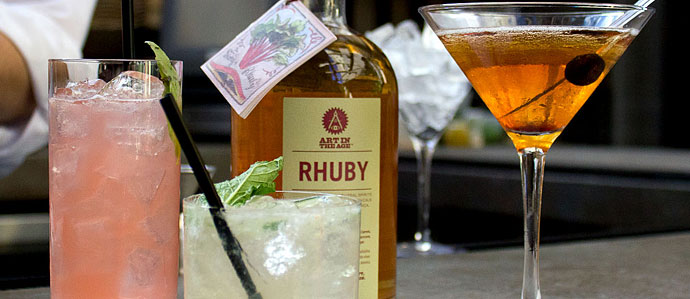 Rhuby. The people in Philadelphia at Art in the Age of Mechanical Reproduction make Rhuby, a sweetish eighty proof infusion of rhubarb flavored with a number of aromatics. It is fitting that Rhuby is a Philadelphian concept (it is distilled under license elsewhere) because during the eighteenth century John Bartram succeeded in growing the first North American rhubarb plants at the garden there that still bears his name. We like Rhuby neat, over a sliver of ice or boosted with a burst of rhubarb bitters and splash of tonic with lime. Go to www.artintheage.com for a selection of other cocktail formulae.
Rhuby. The people in Philadelphia at Art in the Age of Mechanical Reproduction make Rhuby, a sweetish eighty proof infusion of rhubarb flavored with a number of aromatics. It is fitting that Rhuby is a Philadelphian concept (it is distilled under license elsewhere) because during the eighteenth century John Bartram succeeded in growing the first North American rhubarb plants at the garden there that still bears his name. We like Rhuby neat, over a sliver of ice or boosted with a burst of rhubarb bitters and splash of tonic with lime. Go to www.artintheage.com for a selection of other cocktail formulae.
Meat glue. Its more chemical description is transglutaminase, and indeed meat glue is beloved of the molecular gastronomers. It is an enzyme that binds things together, like fat without the fat or a stronger, denser jellied stock, as you might expect from its vernacular name. Handy stuff, and not just for meats; it also makes good lean terrines and potted foods of birds, cheese, fish, vegetables…. Eli’s on Block Island for example builds a superb terrine of shrimp, chilies and nuts mortared with meat glue.
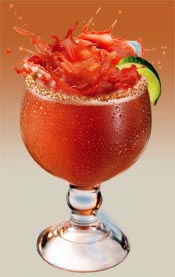 ‘Chelada’ looks like a most unpromising product, and we admit that it is in fact a guilty pleasure, but a pleasure it is. Its marketing targets Hispanic buyers--Spanish is the more prominent language on the can--and for good reason. Cocktails of beer, tomato juice and seasonings have long been popular in Mexico. That, almost, is what Chelada is, but instead of mixing beer and juice, Budweiser brews Chelada with clamato juice and lime. As a result the alcohol content remains at 5% ABV so the drink does not taste at all insipid. Strange, yes, but good on a warm evening, especially spiked with hot sauce, Worcestershire and a little more lime.
‘Chelada’ looks like a most unpromising product, and we admit that it is in fact a guilty pleasure, but a pleasure it is. Its marketing targets Hispanic buyers--Spanish is the more prominent language on the can--and for good reason. Cocktails of beer, tomato juice and seasonings have long been popular in Mexico. That, almost, is what Chelada is, but instead of mixing beer and juice, Budweiser brews Chelada with clamato juice and lime. As a result the alcohol content remains at 5% ABV so the drink does not taste at all insipid. Strange, yes, but good on a warm evening, especially spiked with hot sauce, Worcestershire and a little more lime.
‘Badia’ brand bay leaves. Badia produces dried herbs and spices, and canned goods aimed at the Hispanic market. If Goya surpasses them in the quality of some products, only Badia of the two markets the dried items and they are good. The bay leaves cost literally of a fraction of standard supermarket brands like McCormick and the quality is superior.
The ‘Aerolatte’ milk frother does what it is supposed to do. It churns up hot or cold milk for use with coffee; café au lait, cappuccino and latte without tears. Unlike complicated domestic steamers and brewing contraptions, our Aerolatte has proven both easy to use and durable. Unlike them it does other things too. The Aerolatte is handy for emulsifying small batches of sauce or for auto-whisking salad dressings like English Salad Cream. A useful bargain that costs only twenty bucks or less.
Crabbie’s Original Alcoholic Ginger Beer. Crabbie’s, like Stone’s a British producer of ginger wine, also makes a pair of flavored ales, something we do not ordinarily like at all. The ‘Original Alcoholic Ginger Beer,’ however, is a perfect summer drink. It is bracing, with a cool peppery bite of discernable ginger and, at 4% ABV, a good lunchtime selection that will not send you off to drowse in the humid afternoon heat. The beer laced with orange sounds even better but fails the test, at least to this American palate; redolent of sugary Orange Crush or Fanta rather than bittersweet citrus, perhaps because they make it with orange extract instead of peel.
 Blood orange vinegar. We got our excellent blood orange vinegar at the Extra Virgin Oil Store in Mystic, Connecticut. If the culinary gods exist, then only they share the secret how the enterprise survives, for all they sell are pricey vinegars and oils. We hope they cheat the odds and make a go. All of their offerings are good but the blood orange vinegar is transcendent. The mother comes from white wine and they flavor the vinegar with a blood orange infusion that screams citrus. It makes a good vinaigrette for salads of watercress or romaine and orange segments, and joined by nothing but minced shallot and cracked pepper becomes the best conceivable mignonette for raw oysters. Expensive at about $15 for a half bottle but a little goes a long way.
Blood orange vinegar. We got our excellent blood orange vinegar at the Extra Virgin Oil Store in Mystic, Connecticut. If the culinary gods exist, then only they share the secret how the enterprise survives, for all they sell are pricey vinegars and oils. We hope they cheat the odds and make a go. All of their offerings are good but the blood orange vinegar is transcendent. The mother comes from white wine and they flavor the vinegar with a blood orange infusion that screams citrus. It makes a good vinaigrette for salads of watercress or romaine and orange segments, and joined by nothing but minced shallot and cracked pepper becomes the best conceivable mignonette for raw oysters. Expensive at about $15 for a half bottle but a little goes a long way.

Oyster plates are pretty and practical. The can be utilitarian too; metal trays to line with ice for icy service. The ones of china are more fun, whether plain or ornate, but ornate is best. Oyster plates seem to have proliferated in the Victorian years of riotous deign. Their cups for nesting a shell may be leafed in gold or coated with mother of pearl in shiny mimic of the real thing. Some hold three, others six or more. Some sport handles or central cups to hold a bracing mignonette. The price of antique oyster plates varies as much as the flavor of oysters from different climes. In New Orleans, junkshops sell them for little but Lucullus, while good value for money, charges a lot. You can find new ones in New Orleans as well. At ‘What’s New,’ one of the few good shops in the degraded French Market there, lovely little oyster plates come in bright colors trimmed with gold. They cost less than on Royal Street; a bargain indeed.
Mignonette sauce for oysters. The classic mignonette consists of good vinegar, raw shallot and pepper, perhaps a pinch of salt but nothing more. The Olympia Tea room in Watch Hill, Rhode Island selects Champagne vinegar for its version, an excellent choice. Mignonette should be harsh on an oyster, overwhelming its taste, but for some unfathomed reason the pairing is perfect, almost. As Rowan Jacobsen observes, the vinegar is almost too acid and help is to hand in the person of citrus. It is a surprise but a happy one that he likes blood orange best, over lemon or lime, but it works.
Whole milk. This is a substance that has been barred from many kitchens, even the ones in otherwise fastidious restaurants. What an avoidable decline in the quality of life, and not just when it comes to coffee. How do these places make bread sauce or white (actually most of them won’t, another baleful fact) and what about chowder? Two percent milk may be fine to drink, if you want to be like that and drink milk, but in culinary terms it is the light beer of the dairy industry; no body, no taste, and it will not make coffee white, not really. Two percent, however, has no dearth of adherants, not least among the health police. It was bad enough when EU regulation emasculated the butterfat from Irish and English farmhouse milk, but this is worse. Nonfat milk could drive you to Drink.
Fox & Obel Creole seasoning. Fox & Obel is the great independent grocer in Chicago. They can their own line of dried herbs and spice the way Di Bruno Bros used to do, Creole seasoning among them. Lots of good commercial Louisiana mixes like this are available, and nothing is wrong with them; cooks swear variously by their Tony Cachere’s, their Yogi, their Zatarain’s. You also can take a leaf from the curry snobs’ manifesto and mix your own; most Louisiana cookbook writers include a formula, or simply make one up. There is, however, something special about the seasoning from Fox & Obel. They give nothing away; the ingredients appear on the can only as “Paprika, Garlic, Pepper and other spices.” The presence of thyme and other green herb is, however, apparent, along with little round seed (mustard?). The mixture has a bright clean scent like citrus. It lifts any gumbo, jambalaya or smothery sauce.
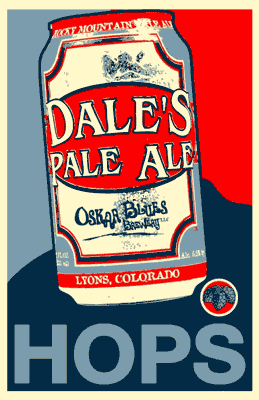
Dale’s pale ale-- in cask! On a rank recent evening our Translator and Miss Dinsmore joined the Editor at the Ginger Man in Manhattan. If the staff could be less unfriendly the beer could not better. The place has a pair of hand pumps that it usually stocks with cask ale and on this night one of them was listed as ‘Oskar Blues Pale Ale’ but this of course was Dale’s. The Colorado brewer names a number of beers and its pale ale is Dale’s. Oscar Blues never bottles, only cans except when they brew dry hopped Dale’s for cask. The canned stuff is good, and could be called an IPA for all its hoppy bite, but it at 6.5% ABV Dale’s is no west coast alcobomb. The cask variant is nothing less than astounding, a bright and classic bitter bursting with blanced flavortones of malt, citrus and pine.
 Hot whiskey. It is appropriate that the Editor first encountered hot whiskey in a Dublin public house, Neary’s, during a soddenly frigid November visit years ago. The drink is elementally Irish, simple, strong and soothing. Drop three cloves into the bottom of a tumbler, top them with a round of lemon and sprinkle it with sugar. Muddle the sugar into the lemon with a pestle or bartender’s bat and add a healthy shot of Irish whiskey; we like Bushmill or Power’s. Set a spoon into the tumbler so that it does not crack when you pour boiling water over the whiskey mixture. If you do not like hot whiskey you are not alive.
Hot whiskey. It is appropriate that the Editor first encountered hot whiskey in a Dublin public house, Neary’s, during a soddenly frigid November visit years ago. The drink is elementally Irish, simple, strong and soothing. Drop three cloves into the bottom of a tumbler, top them with a round of lemon and sprinkle it with sugar. Muddle the sugar into the lemon with a pestle or bartender’s bat and add a healthy shot of Irish whiskey; we like Bushmill or Power’s. Set a spoon into the tumbler so that it does not crack when you pour boiling water over the whiskey mixture. If you do not like hot whiskey you are not alive.
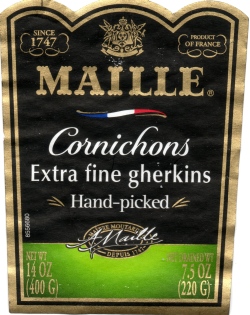
Maille cornichons. You will pay a premium for them but these little pickles juiced with onion and mustard seed outrun anything else on the market. American gherkins tend to the crude and sweet, the Roland imports pallid and tasteless almost to grey. We do like the green screen attached to a notched post; you pull it up out of the jar and hook it on the lip to grab a drained pickle, moving up the ladder of notches as the pickles exit the jar. Excellent to accompany potted meats and marbled veal, recipes for all of which appear in the practical and at our archive.
‘Power Greens!’ . We found this exclamatorily named greens mix from NewStar at a Super Stop & Shop in Connecticut. It is a “triple washed and ready to cook” combination of four “of the most nutritious greens”: baby red and green swiss chard, spinach and baby tat soi, which the label tells us is a “baby green much loved by Asian cooks and folks who shop at farmer’s markets for its hearty, earthy flavor.” They were delicious gripped in a drip of olive oil and steamed in nothing but their own juices. The greens were mild but flavorful, with no bitter aftertaste, a little bit like milder mustard greens mixed with baby bok choy. Nice on their own, but even better mixed with the other varieties.
Lyons country snapjacks. How did these things escape our notice for all these years? Orwell wrote just after the Second World War that commercially baked biscuits and crackers were a glory of British cuisine. He did not mention these oaten crackers among his examples but they represent an exemplar; sweet enough for midnight hunger while sufficiently savory to serve with the sharpest cheese. Widely available in Britain and also stocked by the ShopRite chain in the United States.

The artist Robert C. Smith sent us a bottle of ‘ Chilli Pepper Pete Liquid Fire ’ a few years back. The little bottle itself is pretty and jewel-like, with an artsy silver label and delicate pepper drawings. We dared to try a tiny amount in a Bloody Mary--it is very, very hot but also fruity and adds a subtle punch to the drink. We still have about half a bottle left after several years of use (it is that hot). We went on the Chilli Pepper Pete website to make sure it remains available from www.chillipepperpete.com , but they have changed to a more commercially conventional label. And they now consider Liquid Fire one of their milder sauces; it is hard to imagine how much heat some of their other offerings must throw. Try them too if you are brave or have an asbestos tongue.
Turkeys basters that have a bulb shaped like a turkey. Reproductive jokes aside, turkey basters are handy for siphoning juices from the roasting pan onto the turkey. They also assist in the fabrication of the Editor’s classic stuffing, which appears in our recipe for roast turkey from, appropriately, our recipes. Basters are available with plain round bulbs, but why not spend the same amount on something that might make you smile under the stress of Thanksgiving day?
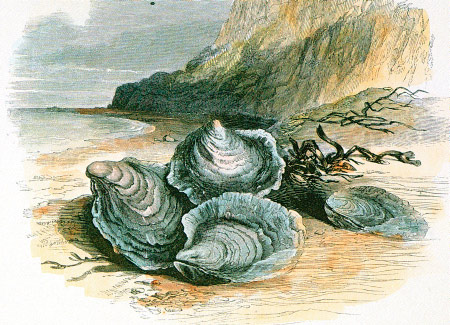 Oyster dressing from Seafood Etc. If you are fortunate enough to find yourself on US Route 1A in Pawcatuck, Connecticut atop a hill just over the line from Westerly, Rhode Island, pull into the parking lot next to Seafood Etc., one of our favorite fishmongers. Their oyster dressing, a seasonal special for the Fall and holidays, is excellent value at five bucks a pound. They use good bread, fresh vegetables, the right blend of herbs and just enough oysters to keep the dressing tangy but not overbearing. Ideal for the harried cook to use as stuffing for turkey, for anybody to stuff a Sunday chicken, or simply as an elegant side.
Oyster dressing from Seafood Etc. If you are fortunate enough to find yourself on US Route 1A in Pawcatuck, Connecticut atop a hill just over the line from Westerly, Rhode Island, pull into the parking lot next to Seafood Etc., one of our favorite fishmongers. Their oyster dressing, a seasonal special for the Fall and holidays, is excellent value at five bucks a pound. They use good bread, fresh vegetables, the right blend of herbs and just enough oysters to keep the dressing tangy but not overbearing. Ideal for the harried cook to use as stuffing for turkey, for anybody to stuff a Sunday chicken, or simply as an elegant side.
Lebanon Bologna is neither Levantine nor Bolognese. Instead, it is a lightly smoked beef sausage the consistency of mild salami. The product is seasoned with a hefty slug of allspice and fermented, like most cured sausages. The result tastes both delicate and assertive. It is unclear whether the sausage originated in Lebanon, New Hampshire or its namesake valley in Pennsylvania. Good versions are available from producers in New England, New Jersey and Pennsylvania, which makes the most aggressive claims for its paternity.
Granville Country Store extra sharp cheddar. People equate American Cheddar with Vermont, Wisconsin and sometimes upstate New York, if not with rubbery processed ‘cheese food product’ or adulterated dip. This cheese from Massachusetts, however, has been made since 1851. It is no curiosity; Granville makes some superb Cheddar, flakier and more pungent than most American versions, and the dairy knows its business, asking customers “to enjoy the unique flavor and texture at its best--eat at room temperature” on every label. The Granville Cheddar is no cooperative blend either, so it tastes of terrior in the manner of Grafton, its better known competitor to the north. Granville Cheddar is available at Breezelands Orchards in Warren, Massachusetts.
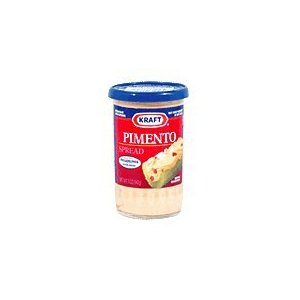
Kraft ‘Pimiento Spread.’ The list of ingredients, if hardly impressive, is not as gruesome as you might assume. But we admit that this stuff is a decidedly guilty pleasure. Food writers raised on the joy of homemade pimiento cheese, justly called the pate of the American south, even have likened the taste and texture of the Kraft impersonator to vomit. That is not fair, and although the Editor seems to remember a lot more of the welcome pimiento in the mix back when her grandmother made savory little sandwiches with the stuff, the taste is not so bad. The texture borders on smooth (good) and rubber (not so good) and lacks the muscular texture of good pimiento cheese but certainly is not chunky, let alone vomitous. After a long day working with ‘colleagues’ bent on their own promotion and your conflagration, a little jar of Pimiento Spread stashed in the fridge can provide some needed comfort along with a handful of water crackers.
Chutneys for cheese from the DP Chutney Collective in Brooklyn. The chutneys by the DP Coop have gotten good reviews from the run of the New York pundits, and while the accolades are accurate, a description of the DP preserves as chutney is not. They are better than other commercial chutneys, and their relative lack of processing sets them apart. The taste sensation of the ‘Triple Berry Bermuda Onion Chutney,’ for example, is sequential; fruit forward, like a Cumberland sauce, but with a brighter, fresh berry flavor; then sour-sweet vinegar and onion; and latterly sneaking heat from “spices” within the labeled list of ingredients--no chili enumerated, but plenty in the jar. It is, however, a little too wet; you may want a spoon. So give yourself a good plane of cheese on a biggish cracker or some toast. Triple Berry mates particularly well with a slice of sharpest cheese and a glass of porter or stout, but buyer beware; a tiny jar that, with discipline, may last a little while will cost you something like $8.00 if you can find it. The word is out.
Pickle Point oysters. 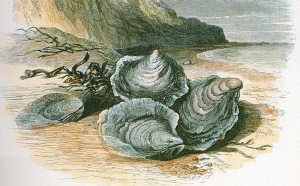 It makes profound sense to farm oysters in the waters off Prince Edward Island. The sea is cold, and if the extreme temperature makes farming relatively expensive--PEI oysters can take as long as seven years to mature--but it also imparts a flavor that is not only mild but also both salty and sweet. In common with most oysters found around Prince Edward Island, Pickle Points have dark meat and deep cups, so they hold lots of lovely liquor despite their small size. Pickle Point lies alongside a national park on the island, and the inshore waters are reliably pure, which should have a great deal to do with the terrific and consistent taste of the oysters. Malpeque Bay yields the famous wild and latterly also cultivated oysters named for their locale, but for our money the more recently named Pickle Points are superior to their fishier neighbors from the east of the island.
It makes profound sense to farm oysters in the waters off Prince Edward Island. The sea is cold, and if the extreme temperature makes farming relatively expensive--PEI oysters can take as long as seven years to mature--but it also imparts a flavor that is not only mild but also both salty and sweet. In common with most oysters found around Prince Edward Island, Pickle Points have dark meat and deep cups, so they hold lots of lovely liquor despite their small size. Pickle Point lies alongside a national park on the island, and the inshore waters are reliably pure, which should have a great deal to do with the terrific and consistent taste of the oysters. Malpeque Bay yields the famous wild and latterly also cultivated oysters named for their locale, but for our money the more recently named Pickle Points are superior to their fishier neighbors from the east of the island.
Old Quebec Super Sharp Vintage Cheddar. An industrial product widely available at least in New England, this cheese is exemplary. It is less creamy and more chalky than Vermont Cheddars, in other words more true to the original English Cheddar than its counterparts in the United States. A worthy entry in the sweepstakes for world class food from Canada.
Tortuga Caribbean Rum Cake.  These pillowy little quarter pound cakes that come in pretty hexagonal boxes have a whopping shelf life of nine months, without refrigeration. Do not be put off; the longevity results from all the rum. The cakes are something like a cross between sodden beignets and rhum babas but despite the linguistic gyrations emerge straight from Barbados and the British tradition. They come from the Caribbean so they are sweet sweet sweet and arrive flavored with banana, chocolate, key lime, pineapple or coconut, our favorite. A guilty pleasure and frugal indulgence at about $6.
These pillowy little quarter pound cakes that come in pretty hexagonal boxes have a whopping shelf life of nine months, without refrigeration. Do not be put off; the longevity results from all the rum. The cakes are something like a cross between sodden beignets and rhum babas but despite the linguistic gyrations emerge straight from Barbados and the British tradition. They come from the Caribbean so they are sweet sweet sweet and arrive flavored with banana, chocolate, key lime, pineapple or coconut, our favorite. A guilty pleasure and frugal indulgence at about $6.
Abita strawberry lager. Going on description alone, this should be an awful beer. Lagers tend not to excite us; flavored beers tend to appall us, even Belgian lambics. Samuel Adams once made a revolting maple cherry beer and the 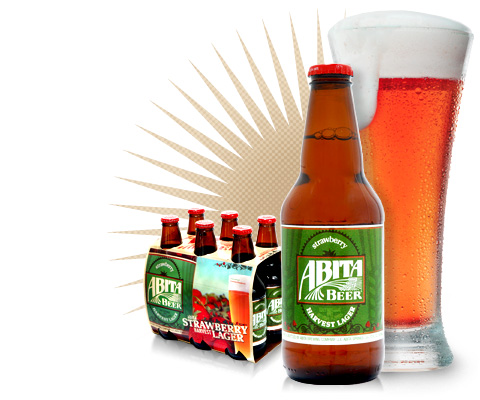 popular Number Nine from Rock Art lasts for about half a glass until it starts to cloy. Furthermore, brews from Abita are a mixed bag. The Jockamo IPA is pretty good, even if it cannot compete with most of its northern cousins, but most of the lagers and ales are bland, although the Turbo Dog lives up to its fabulous name and is as good a classic Porter as we have found. Against odds, the strawberry beer is distinctive too, even dazzling. It has a taut balance between beery depth and berry tang; unbeatable on a hot day, if only on its own or with a Cheddar with some snap like the peerless Valley thunder from New Jersey.
popular Number Nine from Rock Art lasts for about half a glass until it starts to cloy. Furthermore, brews from Abita are a mixed bag. The Jockamo IPA is pretty good, even if it cannot compete with most of its northern cousins, but most of the lagers and ales are bland, although the Turbo Dog lives up to its fabulous name and is as good a classic Porter as we have found. Against odds, the strawberry beer is distinctive too, even dazzling. It has a taut balance between beery depth and berry tang; unbeatable on a hot day, if only on its own or with a Cheddar with some snap like the peerless Valley thunder from New Jersey.
Micau Carmelo Liquido. A Portuguese product; caramel syrup in little 135 gram jars. It is not that hard to boil down sugar for caramel, but this product costs so little (under two bucks) and tastes so good (indistinguishable from homemade) that it is irresistible for weeknight desserts. Dribble it over ice cream, spoon it into the cored cavity of an apple with a sprinkle of cinnamon for baking or improvise some burnt cream. Available in the Newark Ironbound and other Portuguese zones.
Goya codfish in Biscayan sauce. We share the fondness of the Portuguese for salt cod, and should take the opportunity to note that it once was a favorite in England too, served with a remarkably compatible parsnip sauce. The Goya product comes in a 4 oz can, ready to eat cold, like sardines. The sauce is just tomato and spice; maybe someday an enterprising revivalist will use parsnip instead. We do wonder why some enterprising entrepreneur does not market soaked and desalinated salt cod in a vacuum pack.
The Fishery is not a trench in the Grand banks or a zone of Chesapeake bay but rather a shop on the Post Road in Westerly, Rhode Island. It is a fish store that never smells of fish and makes its own cakes. The crab and salmon varieties are good, the curried scallop ones exemplary, but the cod cakes are transcendent. The personable owner will give you his wife’s unwritten recipe for the asking but magic must have intervened in her kitchen. Mashed potato, chunks-- chunks --of the freshest cod seasoned with adobo get a coating of breadcrumbs, nothing more, but these are better than any others we have sampled, nothing less. All you need to complete the feast are a can of beans, bowl of slaw and bucket of beer.
Bottled ginger juice from The Ginger People has a bright fresh bite. It is simply a more pulverized version of their minced ginger in a jar and blends better into liquids. It is also a timesaver so not only useful for making falernum but also for forcing marinades when time is short.
Sunny Caribbee curry powder. Jinx and Jefferson Morgan recognize that self-styled purists who insist on roasting, toasting and grinding separated spice disdain commercial curry blends. They, however, find curry powder handy, even good, and find Sunny Caribbee the best. We like it too. It comes from Tortola and differs from other blends in its inclusion of chicken stock powder, lemon and sesame. It is bracing and bright and available at www.sunnycaribbee.com . They also sell a “legendary world-famous hangover cure” made from bush tea.

Wood’s 100 Old Navy Rum. At 57% alcohol, Wood’s navy rum packs considerable. It also punches even above its weight in flavor; this is not just strong booze for those in search of buzz. The rum, from Guyana on the South American mainland, is made in pot stills rather than using the more modern and less expensive column still method of distillation. The devotion to quality shows; while Wood’s displays the unmistakable hot taste of alcohol, it also includes layered notes of dried fruit, spice and vanilla. As paradoxically seems often the case with overstrength spirits, this is a smooth rum too, easy to mistake for something less potent. Wood’s is superb when you are in the mood for big flavor on a hot day, and marries particularly well with a lime wedge and splash of tonic over ice. But be careful.
The Newark Ironbound. What does a chaotic Portuguese-Azorian-Brazilian neighborhood have to do with British foodways? More than we might think: The superb Port selection at Ferry Liquors is one thing, and the big dressed crabs and fish soup at Seabra's Marisqueria are others. The dressing for the crab is richer than its British cousin but by no means unrelated. The soup is sublime and could hail from London but for the shreds of pasta helix scattered amidst the shellfish. They always have charred roasted quail too. The Ironbound has lots of large and small Portuguese food stores, including cheese makers and a fishmonger with a live eel tank. You can find cockles, salt cod is everywhere, and several stores, including Seabra’s supermarket at 280 Lafayette Street, regularly stock all kinds of offal, including trotters for jellied stock (essential to raised pork pies), kidneys to devil and sheep’s head to shock, or, for the adventurous, to dress in the traditional Scots style. Dining at Seabra’s or Shopping for Port and offal is a good excuse to celebrate Britain's oldest ally and visit the Ironbound; minutes and worlds away from both Manhattan and the Jersey suburbs.
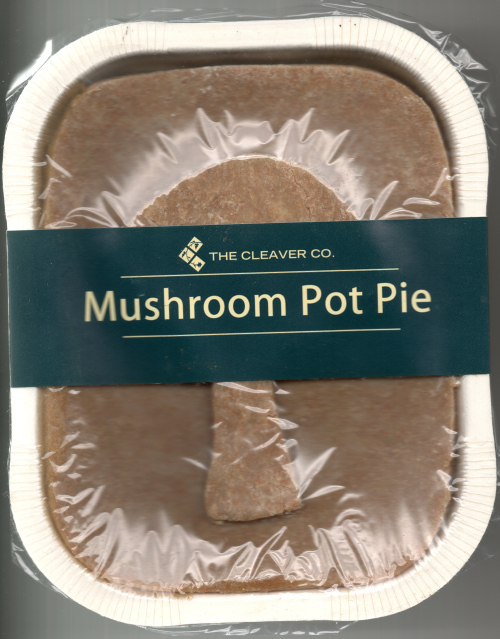 Mushroom pot pies from The Cleaver Company in New York’s Chelsea Market are doubly rare, frozen vegetarian food that is exemplary. The pies make no pretense of aping a meat product, always a good thing, and the whole wheat topcrust stands up to the filling below. It has a variety of mushrooms, various vegetables and a slug of Marsala to enliven the sauce. The company’s restaurant within the market, The Green Table, is small and lovely; the craft beers and artisanal booze in the tiny bar excel.
Mushroom pot pies from The Cleaver Company in New York’s Chelsea Market are doubly rare, frozen vegetarian food that is exemplary. The pies make no pretense of aping a meat product, always a good thing, and the whole wheat topcrust stands up to the filling below. It has a variety of mushrooms, various vegetables and a slug of Marsala to enliven the sauce. The company’s restaurant within the market, The Green Table, is small and lovely; the craft beers and artisanal booze in the tiny bar excel.
Shippam’s crab spread comes in several sizes, including little 35 gram (1.23 oz) jars that cost only pennies; talk about austerity. It is essentially potted crab cut with a little filler, but you get 70% crab and another 10% salmon in the mix. Some of the crabmeat is ‘brown,’ stronger in flavor than the white meat exclusively served in the United States, and Shippam’s crab paste is not for everyone; disrespectful members of the Editor’s household call it ‘cat food.’ It is, however an enduring guilty pleasure, for Shippam’s has been around since 1750.
Black Sheep Ale. The label announces “This is Black Sheep Ale, the culmination of five generations of brewing expertise, brewed at the Black Sheep Brewery in Masham, North Yorkshire – and nowhere else.” We were surprised to find a bottle at a New Jersey liquor store. “Crisp, Dry & Bittersweet” the label goes on to declare. Exactly! The “bittersweet” is prominent, but then -- a full, round flavor that lingers on the tongue. If you can find it, buy it and enjoy it. Cheers.
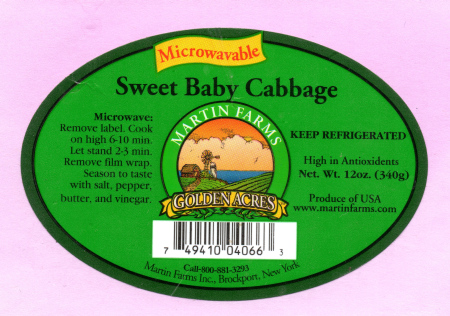 Savoy cabbage. Cabbage has a bad name, because badly handled, usually by overcooking in too much water, it is certifiably... bad. Braised in a drip of stock and blot of butter, however, it is the equal of anything else green (or sometimes red). We like all cabbages; bog standard green cabbage, bok choy, napa, the baseball sized “Sweet baby Cabbage” from martin Farms in New York State that microwave in the package and red cabbage too, but we like Savoy cabbage best of all. It is firm and robust like green cabbage, but its corrugated leaves have better texture and more delicate flavor. Savoy cabbage is essential for making our own cabbage and sausage
Savoy cabbage. Cabbage has a bad name, because badly handled, usually by overcooking in too much water, it is certifiably... bad. Braised in a drip of stock and blot of butter, however, it is the equal of anything else green (or sometimes red). We like all cabbages; bog standard green cabbage, bok choy, napa, the baseball sized “Sweet baby Cabbage” from martin Farms in New York State that microwave in the package and red cabbage too, but we like Savoy cabbage best of all. It is firm and robust like green cabbage, but its corrugated leaves have better texture and more delicate flavor. Savoy cabbage is essential for making our own cabbage and sausage 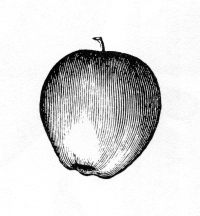 cake .
cake .
Suncrisp apples. We join George Orwell in praise of English apples, from big big Bramleys for cooking to lumpy little Cox’s for anything at all. The Cox’s pippin may be our favorite among all apples but nobody grows it for commercial purposes in the United States because American consumers consider it ugly. In this their culinary reeducation lags behind their take on the tomato. If heirlooms and other lumpy, discolored and delicious tomatoes can wrestle a market niche from what Jinx and Jefferson Morgan aptly describe as the “tasteless pink tennis balls” bred for shelf life and symmetry, then the Cox could give a boost to an enterprising artisinal orchard. Meanwhile, however, we owe a debt to the botanists from Rutgers for their Suncrisp apple. It is a handsome hybrid of the bog standard Cortlandt, dreaded Golden Delicious and vivid Orange Cox; it looks lots like a ‘conventional’ apple and tastes something like a pip.
Compass Box Orangerie. We do not ordinarily like flavored whiskies. They often are a means of masking inferior spirits to unload them on an unsuspecting market. The people at Compass Box, however manage to innovate with integrity, and this is a refreshing whisky product with a lot of character. It is, as the striking label states, “Scotch whisky infused with orange zest cassia & clove.” For some reason there is no comma, but no matter. We like ‘Orangerie’ over a single small cube of ice or chilled chunk of soapstone after dinner in the winter and shoulder seasons of late fall and early spring.
 Veuve Clicquot, please
Veuve Clicquot, please
Wellington water crackers . In Britain they have a superior version of straight water crackers, ‘high bake’ variants that are browner and crisper and do not stick in your teeth. Even the proprietary brands of supermarkets are good. The closest we get to ‘high bakes’ in America is the cracker from Wellington, cooked a little more darkly than the inferior standby from Carr’s. A reason to appreciate Canada.
‘LU’ extra virgin olive oil with sea salt water crackers . Another superior water cracker. Their diction, emphatically not ours, and untraditional to boot. What a good idea, what a flavor boost over conventional crackers. Another good Canadian product; in some ways their foodways echo Britain’s.
 Underwood deviled ham is a venerable product, created fittingly enough by an Englishman in Boston during the middle of the nineteenth century. It is cheap. Essentially a traditional British potted meat, it comes in lovely little cans only three quarters of an inch high wrapped in pinwheeled paper rather than stuck with labels. A merry devil wielding a pitchfork waves to us from each can.Underwood’s is made only of ham, mustard and spice, a classic combination. Softened with a little butter or mayonnaise or both, and sometimes laced with a little old School pickle relish, you could stick it in a pot and serve it as your own.
Underwood deviled ham is a venerable product, created fittingly enough by an Englishman in Boston during the middle of the nineteenth century. It is cheap. Essentially a traditional British potted meat, it comes in lovely little cans only three quarters of an inch high wrapped in pinwheeled paper rather than stuck with labels. A merry devil wielding a pitchfork waves to us from each can.Underwood’s is made only of ham, mustard and spice, a classic combination. Softened with a little butter or mayonnaise or both, and sometimes laced with a little old School pickle relish, you could stick it in a pot and serve it as your own.
‘Fabrique DELICES’ duck rillettes . Yes we know, rillettes are French. This little Canadian product, however, resembles nothing more than potted meat. It is leaner than a true rillette, which really ought to be made from pork anyway. It comes in a little glass jar of 3 oz so it looks like a pot too. Surprising in lightness at 230 calories per, and despite the inclusion of duck fat, maybe not much. At seven bucks a pop, however, it is the antithesis in value of the devilry from Underwood. A defensible treat anyway.
Cape gooseberries appear with increasing frequency on the shelves of North American grocers. They are not really gooseberries at all and lack their bitter bite but are not at all bad for that and make an excellent fool fortified with less sugar than the genuine article. The imposters have an additional virtue as well; they require less work because that need be neither topped nor tailed. Sweet enough to strew over oatmeal or eat like a grape.
Target customer kitchen appliance reviews . Phoebe Dinsmore had to buy a replacement coffeemaker for her collegiate daughter because Phoebe stole hers when her own broke over the summer. We looked at the gazillions of machines available at Target--ones with stainless steel carafes, ones with timers and buzzers, ones that make espresso in tiny cups, ones that make a single cup and ones that make twenty. Cheap ones and very, very expensive ones. Zoning in on the lower priced makers (it was going to be used in a dorm), we read the following review of the “Mr. Coffee 12-Cup Switch Coffeemaker”:
“BEST COFFEE EVVAA December 29, 2009 Reviewer: Lynsey “Coffee Addict” (Kansas)
I got this coffee pot for my dorm ‘cause it was cheap. It turned out to actually work really well. I love it. It works well and has lasted me surprisingly three yrs so far. It gets the job done. I poor [sic] water into it and out comes coffee. And God knows I need my coffee.”
Irrefutable if ungrammatical logic. We ignored “Mom of 2 cats 1 dog” (always good policy in any event) who disliked the way the carafe spills coffee “every time” you pour it (true) and bought yet another machine from Mr. Coffee.
PG Tips teabags . Loose tea is best but bags are handy at the office or when time is short. PG Tips are not artisinal or fancy; they are a workaday product that makes a rich and fragrant cup of pretty maroon tea. No tea smells better. Tips are better than the more expensive English or Irish Breakfast teabags from Twinings, or the teabags by Barry’s from Ireland. American counterparts from Lipton, Red Rose and the like are insipid by comparison. PG tips now are widely available in the United States and represent excellent value for money.
 Food processors , but only grudgingly and for a very few things. Food processors are blunt instruments. Ironically, while they can spiral most anything to a subtle puree, they have no touch. Their utility therefore is limited to the likes of the Edwardian Glamour Cooking espoused somewhat eccentrically by Oswell Blakeston. Texture, however, is nice, so slicing and chopping remain more desirable than mashing. Here, the processor fails the fastidious cook: It is no respecter of nuance, unable to separate fat from lean or run along the grain of meats. It is indifferent to the structure of vegetables and mangles fruit. We forgive the processor all this, however, not just in pursuit of glamour but also for its genius at pastry and shortcrust in particular. Instead of kneading butter and flour for ages with arthritis inducing effort, a cook can throw the switch to good effect for ten seconds. The processor allows for less water too, so its pastry is flakier than our manual efforts. A revelation really.
Food processors , but only grudgingly and for a very few things. Food processors are blunt instruments. Ironically, while they can spiral most anything to a subtle puree, they have no touch. Their utility therefore is limited to the likes of the Edwardian Glamour Cooking espoused somewhat eccentrically by Oswell Blakeston. Texture, however, is nice, so slicing and chopping remain more desirable than mashing. Here, the processor fails the fastidious cook: It is no respecter of nuance, unable to separate fat from lean or run along the grain of meats. It is indifferent to the structure of vegetables and mangles fruit. We forgive the processor all this, however, not just in pursuit of glamour but also for its genius at pastry and shortcrust in particular. Instead of kneading butter and flour for ages with arthritis inducing effort, a cook can throw the switch to good effect for ten seconds. The processor allows for less water too, so its pastry is flakier than our manual efforts. A revelation really.
Maldon sea salt. When we were young and foolish we thought that all vodkas were the same. A bigger budget and curious disposition put the big lie to that one; Popov is to sandpaper what Stoly is to silk. It is the same with salt. Salts vary in flavor, and in contrast to something harsh and iodine like Morton's, a good salt tastes almost sufficiently savory to snack on. Maldon is not the most expensive--some artisanal salts have reached the top shelf, and we cannot bear to reach so deep to get that high--but it may be the best, so it qualifies as good value too. The clear flakes melt on contact and infiltrate their hosts, so Maldon is good for boosting a sliced tomato or seasoning a stew. As a bonus, it is British too.
Darioles. The Editor recently stumbled upon some excellent darioles of French extraction, heavy little slick nonstick molds manufactured by a company called Matfer. The classic function of the dariole is for the creation of the pastry filled with almond cream that bears its name, but darioles are lots more useful than that. They look like outsized thimbles, come in different sizes and are handy in the creation of Edwardian Glamour Cooking, for pretty little custard martellos or just for shaping rice on a special occasion. Now it is true that we are not called frenchfoodinamerica so despite its exotic sound, we were relieved to learn from Kettner’s Book of the Table that the term itself is of ancient English derivation, which may or may not be true. Also according to Kettner’s, the word descends from something meaning ‘maid of honor,’ but we are a culinary enterprise rather than dictionary and space is short.
Whitebait. In reality there is no such thing, for whitebait are an aggregation of many immature species, if predominantly herring and sprat. They are smaller than a petite pinky and eaten entirely intact. Hugh Fearnley-Whittingstall considers whitebait unsustainable in Britain and he therefore begs his readers not to eat them, but they rarely are found in the United States and the ones that do find themselves to table have a provenance of which we are unaware. They are what anglers call baitfish, and frequently find themselves driven onshore during summers in New England by predators and tides to flap helplessly and hopelessly to death. If you find them beached alive, collect them, dust them with flour, flash them in a deepfryer and devour them with a spritz of lemon. Nothing on the planet makes a better starter. Sometimes whitebait make an appearance on the menu of Double Crown (recommended) in New York.
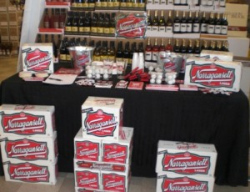 Cheap beer in recession summers. Only two, and not for drinking with food. Only when the discomfort index exceeds 90/90 in New England, we thirst for Pabst Blue Ribbon and Narragansett lager beer. Neither will win prizes at the beer fairs but either stands good comparison to the likes of Budweiser, Carlsberg, Corona, Heineken, Miller and Stella. PBR in its reincarnation beyond Milwaukee is a marketing phenomenon targeting alternative music fans, but the vaguely rich, vaguely metallic flavor is the same that the Editor remembers from 1975. It is best in cans when not on draft. Gansett is a guilty pleasure too, not even brewed in Rhode Island anymore, yet still dedicated to its region while aimed at a demographic similar to Pabst’s but considerably quirkier, and we like quirk. There are puzzles on the underside of the bottlecaps so do not buy cans. Hi Neighbor.
Cheap beer in recession summers. Only two, and not for drinking with food. Only when the discomfort index exceeds 90/90 in New England, we thirst for Pabst Blue Ribbon and Narragansett lager beer. Neither will win prizes at the beer fairs but either stands good comparison to the likes of Budweiser, Carlsberg, Corona, Heineken, Miller and Stella. PBR in its reincarnation beyond Milwaukee is a marketing phenomenon targeting alternative music fans, but the vaguely rich, vaguely metallic flavor is the same that the Editor remembers from 1975. It is best in cans when not on draft. Gansett is a guilty pleasure too, not even brewed in Rhode Island anymore, yet still dedicated to its region while aimed at a demographic similar to Pabst’s but considerably quirkier, and we like quirk. There are puzzles on the underside of the bottlecaps so do not buy cans. Hi Neighbor.

Svelte Watch Hill oysters. The best in the world.
Plump Louisiana oysters. Please survive the oil.
Thomas’s English muffins. You can spend more money, go for organic or artisanal (either and both usually consonant with the greater expenditure), but you cannot find a muffin to match Thomas’s. The ‘nooks and crannies’ they flog are real, and toast up in miracle fashion. They are not, however, English in the least; from Connecticut, other than for pizza otherwise a culinary wasteland.
Vermouth cassis figures prominently in An Armful of Warm Girl by W.M. Spackman (New York 1977), a novella that is both politically unfashionable and recommended reading. The summertime drink is a martini in which the gin becomes dry vermouth and the dry vermouth créme de cassis. Use the same technique and proportions as you would for a dry martini, shake over ice and drain into a martini glass with a peel of lime and, on occasions when madness strikes, a few drops of lime juice.
Bunny Bread. It is unclear from the internet whether the Bunny Bread found in New Orleans is the same product that is distributed in thirteen Midwestern states. We are not familiar with the Midwestern product. The New Orleans bunny, however, is a slightly oversized, square-shaped loaf that toasts beautifully. Its texture is soft but nothing as ethereal as air bread. In My New Orleans (Kansas City 2009), John Besh describes fond childhood memories of tomato sandwiches with Blue Plate mayonnaise on Bunny Bread, a most English notion; Casamento’s uses it to make peerless oyster loaves, which, of course, originated in eighteenth century London. There can be no better endorsements.
 Local hot dogs. Neither the creation of a national market nor globalization, not big agriculture, no force, has succeeded in stamping out the phenomenon of the regional hot dog in America. There are big, bland national brands but no excuse exists for any of them. The regional survivors have heritage; unlike the revolutionary new craft brewers, the little hot dog makers have been around for ages. The dogs themselves vary a lot, but have in common distinctive flavors and textures, (mostly) snappy natural casings and loyal consumer militias within their territories. Chicago has Vienna Beef and the Paulina Market, Milwaukee retains Usinger’s and New Jersey can claim Thumann’s along with the old school German style franks at Joe’s Prime Meats in Hoboken. There are Boar’s Head dogs within and beyond the City of New York, Hummel Brothers in New Haven and little Rhode Island has its own dog too, the beguiling Saugys. There are many, many more and we love them all.
Local hot dogs. Neither the creation of a national market nor globalization, not big agriculture, no force, has succeeded in stamping out the phenomenon of the regional hot dog in America. There are big, bland national brands but no excuse exists for any of them. The regional survivors have heritage; unlike the revolutionary new craft brewers, the little hot dog makers have been around for ages. The dogs themselves vary a lot, but have in common distinctive flavors and textures, (mostly) snappy natural casings and loyal consumer militias within their territories. Chicago has Vienna Beef and the Paulina Market, Milwaukee retains Usinger’s and New Jersey can claim Thumann’s along with the old school German style franks at Joe’s Prime Meats in Hoboken. There are Boar’s Head dogs within and beyond the City of New York, Hummel Brothers in New Haven and little Rhode Island has its own dog too, the beguiling Saugys. There are many, many more and we love them all.
D’Artagnan ‘Free Range Mini Boar Roasts’ . These little roasts with a ponderous name will comfortably serve two with enough leftover for sandwiches, and can feed four with prudent portion control and an extra side. Ours have weighed just under a pound and a half and cost a little less that ten bucks at the supermarket, considerably more online. This price point is a lot less punishing than D’Artagnon sets on most of its products. The ‘mini roasts’ are not really made from boar at all but rather, according to the musketeer’s website, pigs “from a large free-range ranch outside of Quebec” (which, apparently, appears to boast more than maple syrup and poutine) where they “eat nuts, acorns and grasses”--sometimes. D’Artagnan hedges its bet by disclosing that the pigs are “supported at times of need by whole grains;” the ‘mini Boar Roast’ packaging further hedges by describing its contents alternatively as “feral swine,” which sounds a little more ambiguous and a lot less appealing. We do not know how needy the swine are, but these free rangers taste good; the meat is darker, has more depth of flavor and a better texture than incarcerated industrial pork. The meat (from the knuckle) also is extremely lean, so be careful not to follow the instructions from the producer’s website and overcook it.
Bijol ‘coloring & seasoning condiment.’ Bijol is a powder of Annatto, cornflour and cumin aimed at the Latin or Hispanic market in the United States. It is intended primarily for use in paella or to make yellow rice, and fairly obviously is positioned as a poor man’s saffron. Premodern English recipes frequently call for saffron; it grew wild in southern England during Roman times, and the London borough of Croydon derives its name (at some remove) from the Latin for ‘saffron valley.’ We actually prefer Bijol to the real thing in many dishes because we find that even minute amounts of saffron can be cloying.
(Some) canned crabmeat. No food is better than crab, but live crabs take a long time to cook and clean. Fresh crabmeat can be ruinously expensive and goes stale and fishy fast; even crab from reputable fishmongers can go off by the time you get it. Canned, pasteurized crab that requires refrigeration and has a shelf life counted in months instead of minutes is not as good as the fresh meat, but at its best is pretty good. When we want a crab curry, pilaf or soup, and either mistrust the ‘fresh’ meat available or lack extravagant street money, we therefore look for the cheaper canned stuff, especially when it is on sale. The quality of different brands varies a lot, however, so careful selection is mandatory. We have had good luck with the idiotically named “Ocean Delight” brand, good value at $20 for a one pound can.
 Liquid crab boil. Mixed dried spice is superior to the liquid alternative in a traditional crawfish boil, but the alternative is a versatile addition to the cupboard for innovative use in dishes where the traditional bulk mixture would either prove too assertive or stick, like grit, in your teeth. Kevin Graham, whose restaurant empire has vanished as certainly as San Domingue or Ascendancy Ireland, made a transcendent duck slow roasted in a lacquer incorporating coffee and liquid boil. The liquid is a nice addition to potted shrimp or crawfish, and to some crab dishes too, but be sparing; this is spice in grave concentration and the infusion of fennel overwhelms if overused. Both Rex and Yogi are good brands of liquid crab boil.
Liquid crab boil. Mixed dried spice is superior to the liquid alternative in a traditional crawfish boil, but the alternative is a versatile addition to the cupboard for innovative use in dishes where the traditional bulk mixture would either prove too assertive or stick, like grit, in your teeth. Kevin Graham, whose restaurant empire has vanished as certainly as San Domingue or Ascendancy Ireland, made a transcendent duck slow roasted in a lacquer incorporating coffee and liquid boil. The liquid is a nice addition to potted shrimp or crawfish, and to some crab dishes too, but be sparing; this is spice in grave concentration and the infusion of fennel overwhelms if overused. Both Rex and Yogi are good brands of liquid crab boil.
Frozen crawfish tails. Purists, bayou chauvinists among them, will scoff, but we have found frozen peeled crawfish tails completely acceptable and even delicious for virtually all applications. We have heard that the fat turns rancid (none that we have tried have been), that the texture is insipid (not unless you overcook them) or that the flavor is dull (nope). This is not to contend that fresh crawfish are not superior (for confirmation, eat at Clancy’s or Galatoire’s in New Orleans), but unless you know a poacher, own a restaurant, can pay exorbitant express shipping fees or live in Louisiana, you do not have access to fresh crawfish anyway. That is no reason to deny yourself curry, ettouffee, pie or ramekins of potted crawfish. Frozen crawfish from Louisiana is better than the Chinese brands, which unfortunately are cheaper, more widely available and entirely serviceable.
Patak curry paste. A lot is written about the superiority of roasting and grinding separate spices to make your own curry blend, a time-consuming and sometimes awkward task, especially on a tired afterwork weeknight. We are ambitious cooks but never have agreed with the Indian food police that commercial curry blends are illegitimate. Curry powder has its own unique charms and is indispensable to the flavor of many Western curries. We do agree with many of the sticklers, however, that for some dishes a paste is better than a powder; suspending the spice in a medium of oil, tamarind and tomato does seem to brighten the mix and alter the flavor of a curry. It is as unnecessary to make your own paste as it is to mix your own powder when you can buy it from Patak. They make both hot and mild pastes; we buy the mild product and season it up with cayenne or fresh hot chilies.
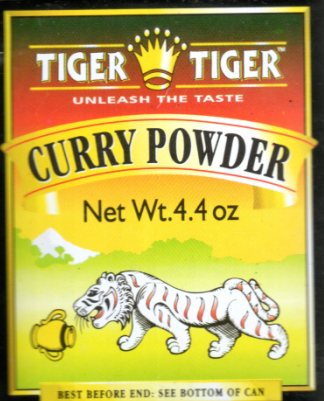 Tiger Tiger curry powder. This is retrograde, even by the standard of curry powder per se. It has an earthy caste, contains salt and is floured, so that if you dust your lamb or chicken and brown it, you will create a de facto roux that accelerates the browning process and eventually thickens the sauce of the curry. The powder is made in India for its British distributor and results in a most Western curry; this is fusion, in a good way, rather than ‘authenticity,’ whatever in fact that means (not, really, much) in the curry context.
Tiger Tiger curry powder. This is retrograde, even by the standard of curry powder per se. It has an earthy caste, contains salt and is floured, so that if you dust your lamb or chicken and brown it, you will create a de facto roux that accelerates the browning process and eventually thickens the sauce of the curry. The powder is made in India for its British distributor and results in a most Western curry; this is fusion, in a good way, rather than ‘authenticity,’ whatever in fact that means (not, really, much) in the curry context.
Geary’s Hampshire Special Ale. How do I love thee. Let me count the ways…
One. The color. Deep woods brown, with citrine sparkles – the bubbles are small and regular, pushing to the surface.
Two. The smell. First of hops, a green spicy scent, and then of alcohol, a bitter edge.
And three. The taste. Both round and sharp, like good Pumpernickel bread and Vermont aged cheddar.
I’ll have another, thanks.
In the past, Hampshire was “only available while the weather sucks.” Happily the ale now remains in production year-round.
 Pieminister pies. We first encountered Pieminister pies at the Portcullis, a great and tiny public house just off of Royal York Crescent in Bristol. All the pies are made by the ministry at their kitchen in Bristol; ingredients are locally sourced. Since our first sighting they have turned up at Borough Market in London and the Covered Market in Oxford. The sublime little pies also are sold from stalls in the Bristol central markets and at the big London market facing Hawksmoor’s quiet Christ Church Spitalfields, one of the best, most original and most spectacular buildings in Europe from any age. Back to the pies, any number of public houses in Scotland and England serve them too. There are both chicken and beef pies with Spanish seasonings, a Thai green curry pie, as well as several vegetarian alternatives and more traditional fillings including minted lamb; pork, leek and apple; and steak and kidney. They all share the same excellent crust, a pastry that is soft and rich on the inside but crisp and crumbly without. Their charming website is at www.pieminister.co.uk ; mail order is available within Britain.
Pieminister pies. We first encountered Pieminister pies at the Portcullis, a great and tiny public house just off of Royal York Crescent in Bristol. All the pies are made by the ministry at their kitchen in Bristol; ingredients are locally sourced. Since our first sighting they have turned up at Borough Market in London and the Covered Market in Oxford. The sublime little pies also are sold from stalls in the Bristol central markets and at the big London market facing Hawksmoor’s quiet Christ Church Spitalfields, one of the best, most original and most spectacular buildings in Europe from any age. Back to the pies, any number of public houses in Scotland and England serve them too. There are both chicken and beef pies with Spanish seasonings, a Thai green curry pie, as well as several vegetarian alternatives and more traditional fillings including minted lamb; pork, leek and apple; and steak and kidney. They all share the same excellent crust, a pastry that is soft and rich on the inside but crisp and crumbly without. Their charming website is at www.pieminister.co.uk ; mail order is available within Britain.
Bath Olivers might be the best crackers of all. They are, somehow, simultaneously crisp and soft. The appealing crunch yields to a rich, almost creamy texture. Olivers are cut to an appealing large diameter and tasted even better when they used to be made with animal fat; increasingly difficult to find in the United States.
Hot port. Not a typo and not for drinking. Elizabeth David observes in Spices, Salt and Aromatics in the English Kitchen (London 1970) that at least until the high Victorian era, “plain port wine, simply warmed, could be served as an accompaniment to game birds such as wild duck and teal; any cook who offered such an unthickened sauce today would consider himself disgraced.” Not us; we agree with David, and she could have added goose, quail and even roast chicken to her list. It can be ruby or tawny port, and it can be cheap.
Coruba original rum. Coruba is the best rum on the planet for drinking with tonic, ginger beer and lesser mixers. It balances sweetness and spice with a hint of burnt cream, and has a brighter and subtler flavor than other dark mixing rums. Myers is plainer and thinner, Cruzan blackstrap is sweetly one-dimensional by comparison. Coruba is a blend, in two contexts. It is produced in Jamaica by Wray & Nephew (the Appleton people) from both pot and column distillates using a solera system so that the base spirit stays consistent, and the name of the rum is a composite of “Companies Rum Basil,” a distillery founded in 1889. The brand, rather than the product itself, originated in New Zealand in 1967; it is a bit of a mystery how and why it found its way back around the world to the United States, and we are pleased that it made the journey.
Ground bayleaf. The food police disdain ground herbs because, they say, they lose their flavor too fast, but not all ground herbs are alike. Rex (a New Orleans company “where spice is the variety of life”) ground bay keeps its pungent tang and, unlike whole leaves, it dissolves so that you can boost the bay tones in purees like pea soup or in cures for duck or pork. Cheap and handy.
Avruga ‘caviar.’ We do not ordinarily like fake food. Vegan ‘sausage,’ ‘imitation’ crab and ‘turkey’ bacon have no place in our larder. We admit that we recognize exceptions though. One example: “Mock turtle’ is a euphemism for calf’s head, and anything made from calf’s head is good. Another example is Avruga “transformed smoked herring product.” We are unsure whether or not it is roe but it has the look and texture, if not quite the taste, of caviar. It is briny and smoky, only about $20 for 2 oz and pretty good with lesser champagnes, so that in these straitened times we are not reduced, like Christopher Walken as ‘The Continental,’ to Cold Duck and Bugles with aerosol ‘cheese.’
Mt. Olive Mild Banana Pepper Rings. We like the heat of chilies, and add a dollop of hot sauce to boost most of our soups, stews and savory sauces. Sometimes, however, heat overwhelms the more delicate of traditional potted foods, cold salmon, shellfish dishes, terrines and other preparations. Mt. Olive peppers are just right; they are balanced, with a hint of heat and are not so vinegary that they overwhelm your smoked fish or wine. These pretty golden peppers from North Carolina are not for cooking; their bright crunch enhances milder cold starters, snacks and sandwiches. They are both inexpensive and virtually free of calories too.
 Prunes. Everybody in America hates prunes. They are not much fun to eat out of the box (but see below), prune juice feels hairy, cold compote at breakfast is cloying and the salt prunes eaten as dessert in Asia are awful. Prunes, however, are transformed by slow cooking with other ingredients. Prunes add the right note to traditional dishes like hindle wakes and various venison pies, especially soaked overnight in tawny Port. Prunes also form the literal core of devils on horseback, a classic savory. Just wrap the prune in bacon, secure the devil with a toothpick and blast it under the broiler until its bacon browns. Sometimes a senior staffer at britishfoodinamerica intends to make devils on horseback after dinner but instead he usually takes a more casual approach and eats prunes straight from the box with a bottle of red wine. We are protecting his identity for the obvious reason. The Swedes and French also know that prunes work. Saveur no.115 includes a good recipe from the Auvergne for a terrine of pork, bread and prunes.
Prunes. Everybody in America hates prunes. They are not much fun to eat out of the box (but see below), prune juice feels hairy, cold compote at breakfast is cloying and the salt prunes eaten as dessert in Asia are awful. Prunes, however, are transformed by slow cooking with other ingredients. Prunes add the right note to traditional dishes like hindle wakes and various venison pies, especially soaked overnight in tawny Port. Prunes also form the literal core of devils on horseback, a classic savory. Just wrap the prune in bacon, secure the devil with a toothpick and blast it under the broiler until its bacon browns. Sometimes a senior staffer at britishfoodinamerica intends to make devils on horseback after dinner but instead he usually takes a more casual approach and eats prunes straight from the box with a bottle of red wine. We are protecting his identity for the obvious reason. The Swedes and French also know that prunes work. Saveur no.115 includes a good recipe from the Auvergne for a terrine of pork, bread and prunes.
Roland Piri Piri With Lemon. Roland Foods, legally “Roland American Food Corp.,” has been around for a long time. They do not seem actually to produce anything; instead, they choose preserved items to import, and they do not always choose well. Many of their products are mediocre or worse, as any casual stroll of the internet demonstrates. Some of their offerings, however, are excellent, and their piri piri with lemon is one of them. The sauce is authentically Portuguese, the primary ingredient is lemon juice instead of vinegar, and the flavor is both hot and subtle as a result. This is a good product from inconsistent Roland.
Bacon rolls. The traditional capstone to a long night or eye opener for the bleary, not necessarily a hangover cure but indisputably an analgesic. Bacon rolls are and are not what they seem; little sandwiches of bacon tucked with a soft little round bread roll. The bacon is not cooked until crisp; it should remain a little chewy, but its fat should leach into the bread for lubrication and flavoring. Sometimes American-style, or what the British call ‘streaky,’ bacon goes within the rolls, and sometimes the leaner bacon, often called ‘Irish’ bacon in the United States, found on British breakfast plates. A bacon roll is just bread and meat, but involves some alchemy; it is more than it seems. A film of brown (steak) sauce or daub of hot English mustard is nice but not necessary.
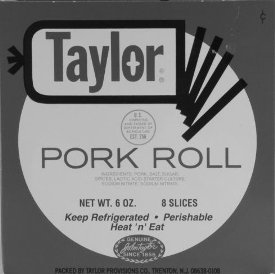 Taylor ham. One of New Jersey’s own peculiar food products, Taylor ham is more a hybrid of salami and Canadian bacon than a variant of ham per se. It is fully cooked but wants to be sliced and fried to serve hot at breakfast or in sandwiches. Saveur, the aspirational food glossy, has even run a short feature on Taylor ham. The manufacturer’s website is www.NJPorkRoll.com .
Taylor ham. One of New Jersey’s own peculiar food products, Taylor ham is more a hybrid of salami and Canadian bacon than a variant of ham per se. It is fully cooked but wants to be sliced and fried to serve hot at breakfast or in sandwiches. Saveur, the aspirational food glossy, has even run a short feature on Taylor ham. The manufacturer’s website is www.NJPorkRoll.com .
Jones sausages. They do not contain much other than pork, salt and sage, and with breakfast sausage less most definitely is more. They are lean, and the small amount of snowy, sagey fat that they throw is worth aggregating in the refrigerator to fry eggs or roast potatoes. We do not know whether the Jones people raise their pigs humanely or not, but theirs are easily the best of all nationally distributed sausages and more than hold their own against the smaller and even artisinal producers. Jones sausages are often sold frozen, and freeze as well as any foodstuff on the market; handy for the ‘pantry.’
Traditional bottled Guinness. We have no complaints about the ‘draught’ Guinness bottled and canned with a nitrogen ‘widget’ to give the stout the smooth head and rich texture of an actual draft. It is a good product, so good that it can be better than draft Guinness carelessly kept. Traditional bottled Guinness is different. It lacks the sweet tinge of the ‘draught’ and has an almost harsh tang that is pleasant. It is stronger than the drafts, both real and imagined, and is downright wonderful with blue cheeses, sardines and other strong flavors. We prefer it for cooking too. This may sound like heresy, but since the traditional stout sold in America has been brewed in Canada rather than imported from Dublin it tastes even better. The big, 22 oz. bottles taste better than the standard six pack size too. Our Staff Photographer will not eat curry without traditional bottled Guinness.
Toast. What is a better friend than toast? It is for breakfast of course, with jam, and makes cheese rabbits possible. It is primeval comfort food late at night with one more beer or on a cold, hungry afternoon between lunch and dinner. The French disdain British food but they do not even have toasters.
Cruzan 'Navy Tradition' Blackstrap Rum. This is an otherwise lost flavor, the taste of the eighteenth century. It is black, sweet, rich, even viscous, and dirt cheap. It is all power and no finesse but surprisingly smooth given the cost. Nice for a change with lime and tonic on a hot, hot day; even better the way the planters of the French Caribbean drank it before the Haitian Revolution, with muddled sugar and lime over just enough ice to cool it without dilution. Blackstrap is the best rum for baking too.
Di Bruno Bros. Whisky Rub. This is essentially flavored salt. It is unclear how the manufacturer gets the sweet and smoky nuance of good Scotch into powdered form; maybe whisky is not really an element of the product at all. That does not matter; this is a delicious dry rub and particularly suited to lamb chops, whether loin, rib or shoulder. It gives the meat a welcome nuance without overwhelming its mildly gamey flavor.
Frozen Puff Pastry. Elisabeth Ayrton offers a lot of good advice. For example: "Do not be afraid of making pastry. It is true the quantities must be fairly accurately measured; butter must never be oiled or even very soft; you must work rather quickly and use your hands lightly and 'rest' the dough as suggested in one or two of the recipes; but on the other hand most [editor's note: The key word here] pastries take only a few minutes to make and none takes more than half an hour." She, and we, draw the line at puff pastry, however, which is as unnecessary as it is unenjoyable to make. Mrs. Ayrton explains: "Again, do not be afraid to buy the excellent frozen pastry on sale everywhere. The puff pastry in particular is so good that it is hardly worth the trouble (and it is trouble) of making your own...." (Ayrton, The Cookery of England, Being Etc. Etc. (1974)) Pepperidge Farm puff pastry is excellent; if you can find it, Dufour is even better, if more expensive.
 Wondra Quick-Mixing flour. Wondra, sometimes called 'instant' flour, is anything but a gimmick or 'convenience' food. It is flour that has been milled to produce sauces and gravies without lumps, and although it is possible to create lumpy sauces with the product, it almost takes an effort to do so. Wondra is a finely ground blend of low-protein wheat and barley flours that is steamed and then dried to produce an extremely fine particulate. It disperses and dissolves faster than conventional flours; that is why it does not tend to form lumps. A lot of chefs keep it on hand and every kitchen should stock it.
Wondra Quick-Mixing flour. Wondra, sometimes called 'instant' flour, is anything but a gimmick or 'convenience' food. It is flour that has been milled to produce sauces and gravies without lumps, and although it is possible to create lumpy sauces with the product, it almost takes an effort to do so. Wondra is a finely ground blend of low-protein wheat and barley flours that is steamed and then dried to produce an extremely fine particulate. It disperses and dissolves faster than conventional flours; that is why it does not tend to form lumps. A lot of chefs keep it on hand and every kitchen should stock it.
 Kitchen Bouquet. The long title is "Browning & Seasoning Sauce for Meat, Gravy & Stew" and the manufacturer should add soup, and especially gumbo, to the list. The product is essentially a home cook's version of the mirepoix that restaurant kitchens keep on hand for adding depth to the dishes enumerated on the label of the bottle. Kitchen Bouquet is not an example of 'better living' through chemistry; it is just caramelized vegetables with salt and a little unobtrusive spice in a water base. You will not taste the presence of the product in your food; the flavor of your food will taste better, more intense. Louisiana cooks have relied on Kitchen Bouquet for years to deepen and darken gumbos and meat stews; it is less risky than darkening roux all the way to the verge of burning and ruin. Try it: Kitchen Bouquet is a cheap and useful product.
Kitchen Bouquet. The long title is "Browning & Seasoning Sauce for Meat, Gravy & Stew" and the manufacturer should add soup, and especially gumbo, to the list. The product is essentially a home cook's version of the mirepoix that restaurant kitchens keep on hand for adding depth to the dishes enumerated on the label of the bottle. Kitchen Bouquet is not an example of 'better living' through chemistry; it is just caramelized vegetables with salt and a little unobtrusive spice in a water base. You will not taste the presence of the product in your food; the flavor of your food will taste better, more intense. Louisiana cooks have relied on Kitchen Bouquet for years to deepen and darken gumbos and meat stews; it is less risky than darkening roux all the way to the verge of burning and ruin. Try it: Kitchen Bouquet is a cheap and useful product.
Malt Vinegar. It remains de rigueur among self-styled English epicures to despise malt vinegar. Elizabeth David hated it and none of the great writers of her time have much time for it either. Why? Probably it was because what passed for malt vinegar in 1970s Britain was a bad product, harsh and adulterated and shambolic. Good malt vinegar is available today, however, and we like it for its depth of assertive flavor. Why add wine vinegar to Beef Guinness or Rabbit with Ale & Barley? Use like with like and never eat French Fries without a sprinkle of the malt, Rhode Island style.
Mushroom Ketchup. This is a condiment that was widely used during the eighteenth and nineteenth centuries. It remains available if underutilized in the United Kingdom but has virtually disappeared from the United States outside of a few enterprising southern home kitchens. It adds a bright and pungent highlight to sauces, soups and stews. The ketchup is easy to make and most of the older cookbooks have recipes for it; our favorite one comes from The Gift of Southern Cooking by Edna Lewis and Scott Peacock (2003). A decent commercial brand is "The Original Recipe by Geo. Watkins" from G. Costa & Co. Ltd. in Alesford, Kent.
 Worcestershire. This may seem too obvious a choice but it is too versatile and good to omit. A splash of Worcestershire lifts almost anything savory and should find its way into almost every sauce, soup, stew or dinner pudding. It is also good, if assertive, added at table to grilled and fried meat, birds and game. Oddly enough, a number of good, lightly oily versions appear in various Louisiana cookbooks but that effort is for the curious and the few when the commercial product is so good: It must be Lea & Perrins, nothing else. A number of Brazilian and Portuguese companies produce a variation of Worcestershire too, called Molho Ingles, that is interesting and useful for a change of pace in Bloody Marys, but otherwise just not the same. Fortnum & Mason markets a milder variant that it calls "King of Oudh's Sauce." It adds sweet and savory things including wine vinegar, redcurrant and citrus to a Worcestershire base.
Worcestershire. This may seem too obvious a choice but it is too versatile and good to omit. A splash of Worcestershire lifts almost anything savory and should find its way into almost every sauce, soup, stew or dinner pudding. It is also good, if assertive, added at table to grilled and fried meat, birds and game. Oddly enough, a number of good, lightly oily versions appear in various Louisiana cookbooks but that effort is for the curious and the few when the commercial product is so good: It must be Lea & Perrins, nothing else. A number of Brazilian and Portuguese companies produce a variation of Worcestershire too, called Molho Ingles, that is interesting and useful for a change of pace in Bloody Marys, but otherwise just not the same. Fortnum & Mason markets a milder variant that it calls "King of Oudh's Sauce." It adds sweet and savory things including wine vinegar, redcurrant and citrus to a Worcestershire base.
The Fishery is not a trench in the Grand banks or a zone of Chesapeake bay but rather a shop on the Post Road in Westerly, Rhode Island. It is a fish store that never smells of fish and makes its own cakes. The crab and salmon varieties are good, the curried scallop ones exemplary, but the cod cakes are transcendent. The personable owner will give you his wife’s unwritten recipe for the asking but magic must have intervened in her kitchen. Mashed potato, chunks-- chunks --of the freshest cod seasoned with adobo get a coating of breadcrumbs, nothing more, but these are better than any others we have sampled, nothing less. All you need to complete the feast are a can of beans, bowl of slaw and bucket of beer.

